#to build a better world: choices to end the cold war and create a global commonwealth (book)
Explore tagged Tumblr posts
Text
How the World Fell Under Darkness: A Zones Timeline
In brief format. Hits the major events, skips so much of the daily tragedies.
50s — post World War II relations and recovery
60s — the Cold War of intelligence and counterintelligence, fear campaigns; the arms race keeps everyone afraid of each other on a global scale
70s [diverging point from actual history]— the conflict goes hot, the world goes ugly; in America, only two large settlements survive the bombings, near LA in the west, and a fortress in the south- Better Living establishments which were protected from the damage in advance, seeing as they built a large number of the weapons used (by both sides)
1980-1984 — radiation is scrubbed from choice locations in the east, and Empire is founded, establishing a port for BL/ind's relations with other surviving entities
1985-1989 — following a health crisis in the south, the Analog Rebellion begins in Fort F.I.S.K. and spreads as people break free of the fort, skirting through what habitable land remains, and group together; the idea catches, and as the numbers of resistance climb, both Battery and FISK are cornered into retaliating
1990-1994 — rebellion continues, escalating into mass casualties on both sides- casualties no one can afford, in a world already post global war
1995-1999 — tenuous ceasefire is declared; it's not peace, but it's not war. the cities build walls, closing themselves in, and those that left the settlements are abandoned to the wilds to eke out whatever life they can without aid from Better Living
2000-2004 — the lands surrounding FISK backslide, and become entirely uninhabitable or navigable without specialized equipment; Empire City receives its first "transfer" from beyond the cities
2005-2009 —the zones around Battery begin to experience more regular patrols and tensions between city folk and desert folk fray
2010-2011 — Better Living develops ReEducation; patrols and raids into the desert become more violent in nature, and zone folk are disappearing (not killed, just gone)
2012 — a series of fire storms -"The Fires of 2012"- start west of the city and sweep the zones all the way to the Fort; both sides experience minimal casualties, but lots of structural and food supply damages
2013 — widespread unrest in the zones and a significant amount of infighting; recovery efforts in the city and a significant amount of infighting
2014 — The Collapse -a yet unexplained mass casualty event- takes place in zone five to the northeast of Battery City, effectively reducing the population of the zones by a third; more die off in the months afterward of bizarre afflictions and injuries, often going mad in the process. the city blames disease, spreading it as anti-zones propaganda among citizens; the desert creates the Destroya mythos; while the desert is distracted, the city creates and new addition to the west of it outer wall, expanding the lower city into an area that would come to be (colloquially) called "the slums"
2015 — the Fabulous Four, though only teenagers, begin to become notorious, making their fame by pushing back violently as Better Living begins to expand its reconstruction efforts in zone one, seeking to reclaim it as part of the city
2016 —killjoys get bold, and the city suffers a sudden unbalancing as a large number of young people find ways into the desert; in-city raids, especially of lower districts, become common as BL/ind cracks down on smugglers and introduce new security measures to the walls surrounding the city
2017 — the Fabulous Four are declared public enemies 1-4. Exterminator Korse is assigned to end the threat
2018 — everyone on the edge of their seats as Korse and the Fab Four are locked in a power struggle that becomes the embodiment of city vs. desert; almost all other directly physical city/desert confrontation has ceased, except in service of aiding their champion(s). Dr Death's broadcasts updating listeners on the events of fights and escapes are the most listened to thing on both sides
2019 — the Fabulous Four destroy the eastern checkpoint, storm the city, and decimate the S/C/A/R/E/C/R/O/W headquarters before, ultimately, falling in battle; all for one little girl. they become Martyrs.
2020 — the dark year. Better Living seems inescapable, the killjoys are scattered and scared, and a great many are killed or disappear into reEd. some return to the city without being captured. those who remain are more certain than ever they can never give in. despite killjoy interference, part of northern zone 01 is annexed into the city for new farming and production
2021 — the Fab Four reappear in the zones. some say they were never killed after all, a few become suspicious they are reEd's, or android dupes of the originals, but by and large the mythology of their martyrdom lends to another explanation altogether: they've been brought back to life by the desert itself to lead the fight. they are solidified as the Heights of killjoy fame, bulletproof and lauded, even outright worshiped by some; hope returns
2022 — there are several building collapses and series of fires in the newly expanded Neon District; rumors of a rogue city agent as well as stories about Perro -a mythical figure from the zones- being responsible both go flying in all directions. nobody's really sure what happened, other than that a lot of citizens and neutrals died (that is, nobody publicizes what actually happened)
2023 — as part of their recovery efforts, the city attempts to smooth relations with neutrals and claim land in the zones, establishing several greenhouses almost literally overnight; in answer, most are destroyed by the killjoys, the two left standing are claimed by rebel crews and renamed into independent settlements
2024 — emboldened by the destruction of the greenhouses, a killjoy leader of a particularly violent group attacks the city directly; the city retaliates, destroying a peaceful settlement in zone three. both sides are criticized by their allies, the resulting unrest spans both city and zones
2025 — the Destroya Rampage unfolds. zone five and parts of six go dark, nothing but static on every radio for months. entire crews from both sides (local killjoys & investigative excursions from the city) are lost, seeming to turn on their own while within these 'dark zones'. several massive dust storms sweep over Battery City and the surrounding zones, causing blackouts and widespread interference with broadcasts and electronic systems of every type. fighting between the city and desert scales back as the environmental conditions threaten everyone
2026 — the sandstorms are replaced by torrential downpours (which sounds good but isn't, in the desert), some of which are typical rain and some of which burn on contact- relatively normal in the outer zones, but unheard of in the city. city initiatives focus on re-assuming relative control over the city's climate, desert settlements focus on surviving.
2027 — weather patterns gradually begin to stabilize in the city; in the desert, old secrets -uncovered by the winds and rains- begin to surface. whether they lead a new charge against the city or destroy the fragile balance of the desert . . .
2028 — . . . Remains to be seen. The whispers gather, but don't seem to go anywhere. Things have gone still and quiet -as still and as quiet as they get, anymore- and the only sure about a staring contest is that someone has to blink, eventually. something will shift, everyone's waiting for it, waiting to see which direction the world tilts this time
2029-2030s — You Are Here. Don't panic. Keep running.
#c:\\work>dir z:\ wld:bld* //.insp .stdy/#hi if this found its way to you this is purely for me n my friends headcanons and not an assertion of overall actual canon ty ♥
4 notes
·
View notes
Text
Turnkey Commercial Fit Out vs. Design & Build: What’s Actually Best for Your Bottom Line?
Let’s cut to the chase: You’re standing in your new raw office space, half-excited, half-terrified. The concrete floors echo, the walls are bare, and your to-do list includes everything from wiring outlets to picking doorknobs. Do you hand the whole mess to one team and pray? Or micromanage every tile and light switch?
Here’s the cold truth—56% of businesses regret their fit-out choice within a year, often because they picked the wrong model for their goals (2024 Global Workplace Report). I’ve seen it firsthand: A startup blew 40% of their budget on a "custom" Design & Build office, only to realize their layout didn’t support hybrid work. Another client went Turnkey and got a cookie-cutter space that felt nothing like their brand.
Let’s break down the two approaches without the fluff. By the end, you’ll know exactly which path won’t keep you up at night.
Turnkey: The “Done-for-You” Dream (or Nightmare?)
You know those all-inclusive resorts where you just show up? Turnkey is the design world’s version. One team handles everything—permits, plumbing, even potted plants. But here’s the kicker: Not all Turnkey providers are created equal.
The Good:
Speed: Projects finish 30% faster on average (JLL Fit-Out Study, 2025).
Predictable Costs: No surprise invoices for “forgotten” fire alarms.
Tech Bundles: Many include pre-negotiated IoT systems (motion-sensor lights, smart HVAC).
The Ugly:
Generic Designs: Ever seen five dentist offices that look identical? That’s Turnkey’s dark side.
Hidden Limitations: “Customization” often means choosing between three shades of beige.
Best For:
Franchises, coworking spaces, or anyone who needs “good enough” fast.
First-time business owners who’d rather not learn building codes the hard way.
Real Talk: A client in Miami saved 4 months with Turnkey but later paid double to rip out “standard” acoustic panels that failed in their podcast studio.
Design & Build: Your Vision, Their Headache
This is the “choose your own adventure” route. You hire a designer to dream up that industrial-chic-meets-Japandi vibe, then a contractor to (try to) execute it.
The Good:
Total Control: Want a 3D-printed reception desk shaped like your logo? Done.
Sustainability: Source reclaimed barn wood or mycelium insulation without pushback.
Unique Solutions: Perfect for labs, medical offices, or brands where aesthetics = identity.
The Ugly:
Budget Creep: That “small change” to add USB-C ports? Congrats, it just cost $12K.
Timeline Roulette: One contractor’s “6 weeks” is another’s “6 months.”
Best For:
Heritage buildings with “character” (read: uneven floors and asbestos surprises).
Brands where the space is the marketing (think Glossier stores or Tesla showrooms).
War Story: A NYC bakery opted for Design & Build to get a vintage oven as their centerpiece. The oven arrived… but the gas line couldn’t handle it. Cue 11 weeks of delays.
The 2025 Game-Changer: Hybrid Models
Why pick one? Savvy firms are mixing both. Use Turnkey for the bones (electrical, plumbing, drywall) and a designer for the “wow” elements (lighting, art, branded zones).
Example: A Berlin fintech startup used Turnkey to build out 80% of their office, then hired a local artist to hand-paint murals in breakout rooms. Saved 22% vs. full Design & Build.
5 Brutally Honest Questions to Ask Before Deciding
“How much do I really care about design?” If your answer is “I just need desks and Wi-Fi,” stop here. Turnkey’s your jam.
“What’s my pain tolerance?” Design & Build means weekly decisions—down to hinge finishes. Got the stamina?
“Can my budget handle a 20% oops?” Always reserve a contingency fund. Always.
“Do I have a designer friend on speed dial?” If not, Turnkey’s pre-packaged designs might save your sanity.
“Will this space need to pivot in 2 years?” Turnkey’s modular setups adapt easier to hybrid work or expansions.
The Verdict: It’s Not About Better—It’s About Fit
Turnkey is like buying a Tesla: sleek, efficient, but limited to what’s on the menu. Design & Build is restoring a ’67 Mustang: glorious, personal, and prone to engine fires.
In 2025’s hybrid-work era, 73% of employees say workspace quality impacts job loyalty (Gallup). So ask yourself: Is your space a commodity or a core part of your brand?
0 notes
Text
World War Z was published in 2006, but takes place in 2009 at the earliest. Late in the book, astronaut Terry Knox states that the International Space Station took over 10 years to complete; it started construction in November 1998, and Chief of Staff Karl Rove Grover Carlson says that the Republican party barely eked back into power after a disastrous 2-termer who started a “brush fire war” in the Middle East (George W. Bush). He mentions an election year, but he doesn’t specify if it was the new president’s first or second term, so it’s either set right after 2008 or 2012. This was written before the Nintendo Wii was announced, but one chapter mentions that people brought their GameCubes with them as they fled their homes in search of safety in the frozen Canadian wilderness. This same chapter also mentions that they didn’t know how to pick survival gear; a park ranger finds a SpongeBob SquarePants sleeping bag frozen in the mud because its owner didn’t know the difference between a child’s indoor sleeping bag for slumber parties and a real insulated survival bag for camping.
The new president is never named, he’s just told be be pro-big business and anti-regulation, pushing a placebo zombie vaccine through the FDA to jumpstart the economy. When shit hits the fan, he is “sedated” and his vice president takes power; we’re never told what happened to the president, whether he was bitten or had a stroke, just that he was “sedated.” His Vice President is directly implied to be Colin Powell; he’s former military with family in Jamaica and black. He appoints Howard Dean to be his vice president to form a bipartisan coalition; he is never referred to by name, but it is clearly supposed to be Howard Dean. He was a rising star in the Democratic party from Vermont whose wife is a doctor and whose career imploded after he had a passionate outburst. In 2004, Howard Dean gave a speech where he started passinately screaming about how he was gonna start sweeping state primaries and ride a wave into the White House, punctuating his point by going “HHEEUEAHHGH!!” This was political suicide in 2004, and he was laughed out of the race. In the book, he is referred to only as “the Whacko” because of this. It is implied that he was Powell’s second choice for VP, his first being Barack Obama; the Whacko says that the Democrats wanted somebody else, somebody of the same skin color as the president, but that the country wasn’t ready for that. In 2004, Obama was a candidate for senate in Illinois, so popular and so well spoken that he gave a speech at the Democratic National Convention before he even won his seat; then and there, pundits already had him pegged as the first black president, they could see the writing on the walls. The Whacko becomes president when Powell dies of stress, but he is consistently referred to only as the wartime Vice President, out of respect for his boss.
Also, the Attorney General is implied to be Rudy Giuliani; all that is said about him was that he was the mayor of New York and once tried to give himself emergency powers to stay in office after his term. Giuliani did exactly that after 9/11.
Other real life figures mentioned in the book
Fidel Castro; a ton of Cuban Americans flee the continent and return to the island during the zombie war, and he jumpstarts the economy by putting them to work as cheap laborers and slowly integrating them back into Cuban society. He rehabilitates his image by stepping down as dictator and democratizing the country, voting himself out of office before the “nortecubanos” could hang him for decades of war crimes.
Nelson Mendela, referred to by his birth name Rolihlahla, the father of modern South Africa, he personally invites Paul Redekker, a former apartheid era political analyst, to solve the zombie problem; in the 80s, Redekker created a plan for the white minority government in case the black majority ever rose up against them. In real life, Mandela lowered the temperature when he was elected president, saying that revenge against the apartheid government would do more harm than good. In the story, Mandela uses this as justification to reuse the apartheid era plan to handle the zombie outbreak instead. Redekker is so overcome by his compassion and forgiveness that he has a mental episode and dissociates, believing himself to be a black South African.
Kim Jong-il, the dictator of North Korea, he withdraws all troops from the DMZ and shuts the entire country down. After months of radio silence, it is revealed that the entire country’s population has vanished; all satellite imagery shows a desolate wasteland, no zombies, but no humans either. He presumably moved everyone into subterranean bunker systems where he not only control their lives as on the surface, but now their access to food, water, and air. He presumably became the god emperor he always wanted to be; either that, or the entire tunnel complex has been overrun, turning every man woman and child in North Korea into zombies. The South Korean government refuses to send a expedition into the North to figure out what happened, lest they open up one of the tunnels and unleash millions of zombies onto the surface.
Martin Scorsese, mentioned in passing only as “Marty,” a friend of world famous film director Roy Elliot, who himself is a thinly veiled pastiche of Steven Spielberg. Interestingly enough, the audio book features Martin Scorsese doing the voice of the conartist who created the placebo vaccine
One chapter has a ton of vapid celebrities hole together in a fortified mansion on Long Island, and takes great care to show each of them getting torn apart not by zombies but by regular people who storm the facility because they were stupid enough to broadcast their location on reality television. A redneck with a “Get’er Done” hat (Larry the Cable Guy) and some bald guy with diamond earrings (Howie Mandel) blow themselves up with a grenade. Rival political commentators, an annoying guy who talks about feminization of western society and a leathery blonde (Bill Maher and Ann Coulter) have end-of-the-world viking sex as the facility burns to the ground. A dumb starlet (Paris Hilton) is killed by one of her handlers and her little rat dog escapes on foot. A radio shock jock (Howard Stern) actually survives the war and restarts his show.
Michael Stipe of REM joins the army to fight the zombies
Another war veteran mentions how his brother used to have a bunch of Mel Brooks’ old comedy skits on vinyl record, and how he and his squad acted out the “Boy meets Girl” puppet skit with some human skulls. Mel Brooks is author and narrator Max Brooks’ father.
Queen Elizabeth II, refuses to evacuate England when the island is overrun by zombies. She intends to remain in Buckingham Palace “for the duration,” mirroring the fact that her parents refused to evacuate to Canada during World War II.
Vladimir Putin declares himself Tsar of the Holy Russian Empire, an ultra-orthodox religious state that has armed priests execute political dissidents under the guise of mercy killing people who have been bitten by zombies.
Yang Liwei, the first “taikonaut” (Chinese astronaut) has a space station named after him
While the main conflict is about government responses to the zombie pandemic, we see glimpses of a greater war torn planet.
A major plot line involves a Chinese Civil War which sees the entire communist politburo nuked out of existence by a rebel sub commander, as well as an attempted “scorched space policy” where the government planned to blow up their space station with scuttling charges to cause a cascade of space debris to encircle the Earth and prevent any other countries from launching missions in the future (this is known as Kessler Syndrome in real life, and was featured as the inciting incident of the 2013 movie Gravity). The People’s Republic becomes the United Federation.
Iran and Pakistan destroy each other in nuclear war; everyone thought it would be India and Pakistan, but they had very close diplomatic infrastructure in place to prevent such a catastrophe; Pakistan helped Iran build a nuclear arsenal, but as millions of refugees fled from India through Pakistan to the east, Iran had to blow up some Pakistani bridges to stem the flow of zombies, which led to a border war and eventually total nuclear retaliation.
Floridians flee to Cuba, Wisconsinites flee to Canada, the federal government flees to Hawaii. Everything east of the Rockies is abandoned and ruled by warlords until the government sorts itself out and mounts an expedition to clear the continent of zombies by literally marching an unbroken line of soldiers stretching from Canada to Mexico across the wasteland to the Atlantic.
Israel withdraws from Gaza and the West Bank to become super isolationist, building a wall around the entire country to stop the zombies getting in (they were the first country to respond to the pandemic, and the most successful), but the religious right rebels against the secular left in a civil war that sees Jerusalem ceded to a unified Palestine.
It is an amazing, multifaceted story with so much going on that nobody recognizes. It was written as a response to the end of the Cold War and the start of the War on Terror. It’s about a geopolitical shift, a change in the status quo, a disaster from which the world never recovers; America before 9/11 was a very different place than American after 9/11. Iraq and Afghanistan changed everything, and we’re still feeling their effects to this day; the story uses the zombie apocalypse as the next big international disaster the world must adapt to. World War Z is World War III with zombies, and I think it would do a lot better if it were published today, now that we’ve had several decades to respond to the fall of the Soviet Union and the endless wars in the Middle East and a global pandemic.
138 notes
·
View notes
Text
RWBY V07E02 - A New Approach
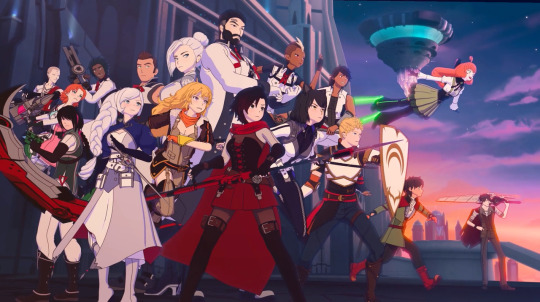
Aaand we're back! Last episode a dangerous band of vigilantes was arrested by the valiant Ace Ops. You can rest easy, citizens of Mantle, your streets are safe again. Or are they? Let's do this!
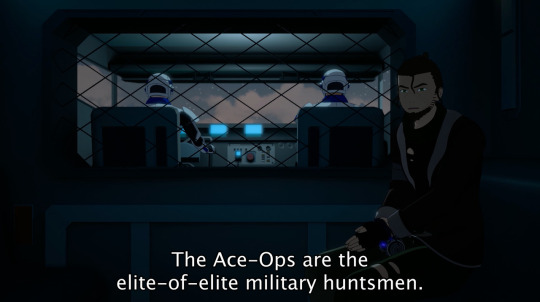
He was arrested for dumping world building on unsuspecting people.
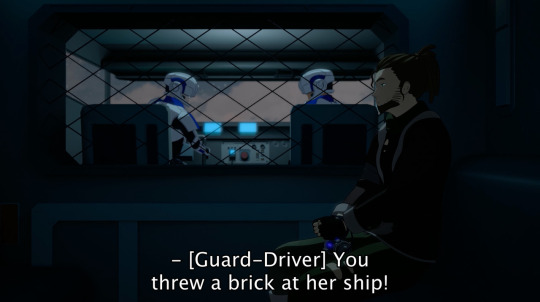
Her ship? Winter? Ooh, that guy is dead.

I'm not sure I like the introduction of something as good as "better conditions in Mantle" coming from someone who the show is not taking seriously. Even the music is lighthearted.
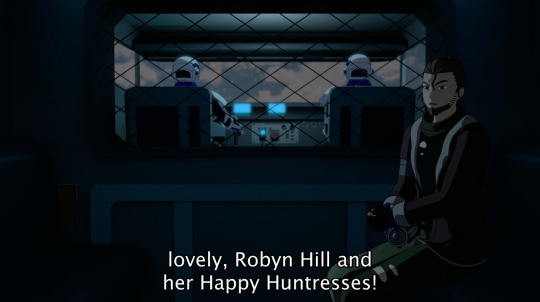
...they are not being subtle about Robyn Hill being a reference to Robin Hood, huh?
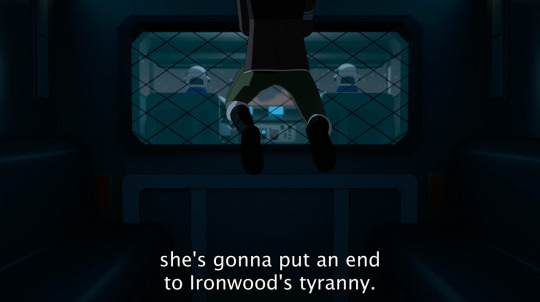
Again, I'm not sure what's up with the tone. Why is _this_ the first impression we get of Robyn Hill's movement? Is it because Ironwood is coming and we need to see his side before Hill's thing is presented as something more serious?
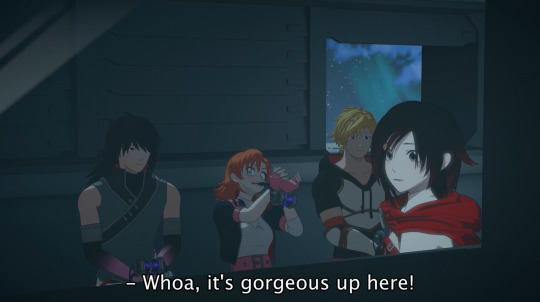
I haven't commented on it but background Nora has been a delight.
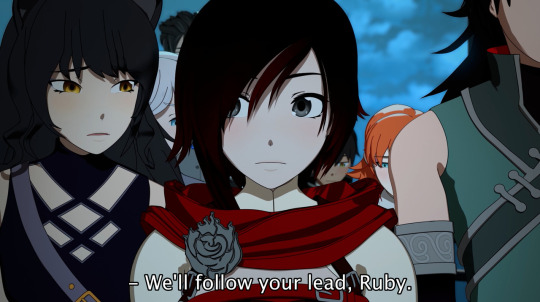
The second time Blake speaks to Ruby this season. Ah, how times change.
This could be a "you're a making a great mistake" moment but I have faith in Ruby.
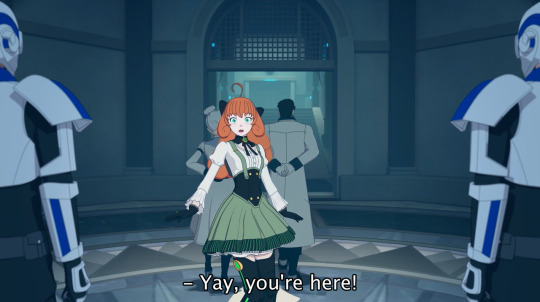
I was prepared to not see Penny again for _episodes_ but here she is. The RWBY Gods are generous today.
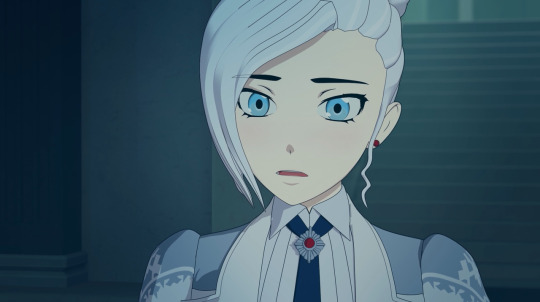
She missed her! I think? She's surprised but her expression doesn't exactly scream happiness... but then, she has smiled maybe twice in the show.
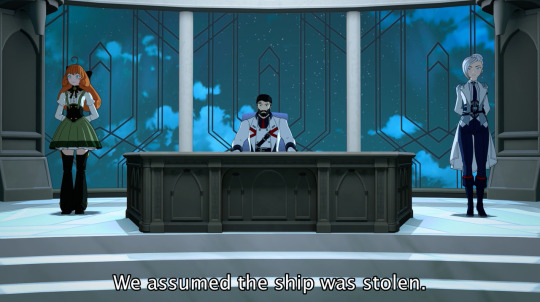
I like how Ironwood's both metallic and human side are represented by Penny and Winter. And how their demeanor usually represents the opposite, with Penny being a lot warmer and open than Winter's cold nature.
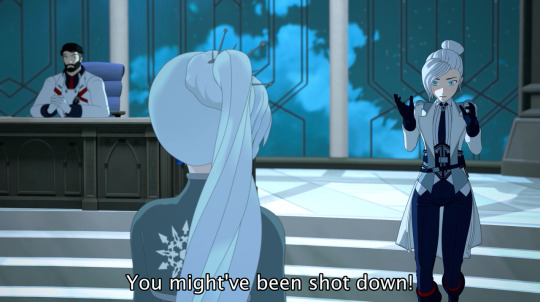
Aw, she really was worried about Weiss. And Ironwood in the back wondering what's wrong with his usually ice-cold, professional to a fault right hand.
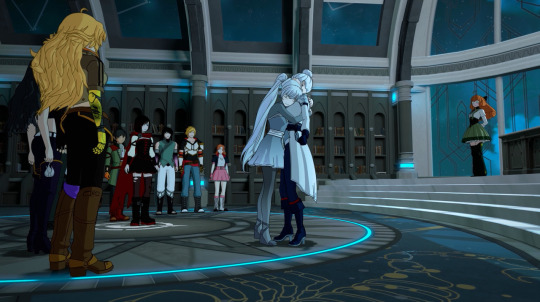
Weiss's hugs are incredibly powerful, as seen in Volume 5.
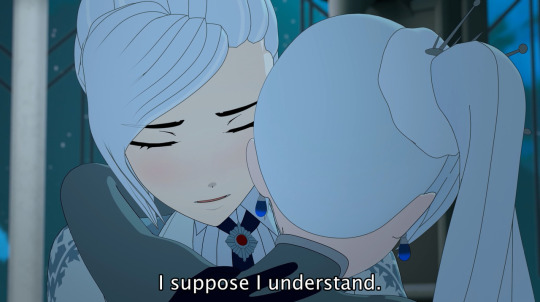
They can even defeat Winter.
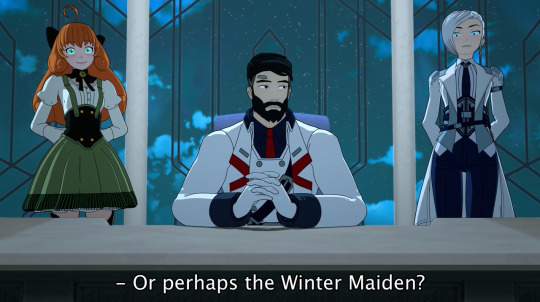
There's something very suspicious about how they in shadows. Penny looks almost menacing with the way her eyes shine.
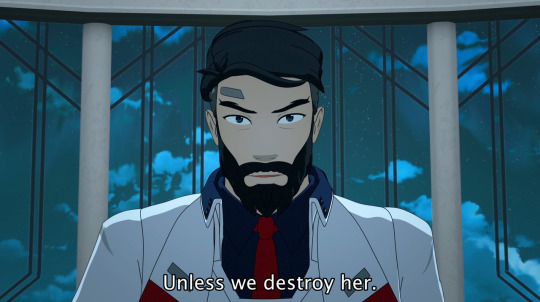
Uhm. About that.
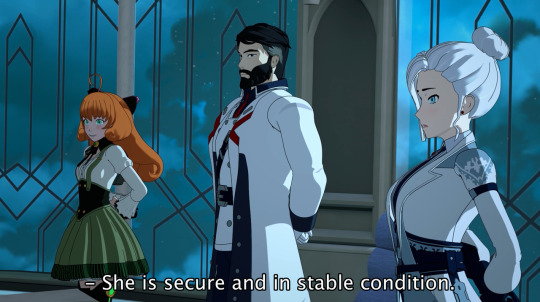
Huh, so she got attacked too?
Many volumes ago I thought that Penny was a candidate for being the Fall Maiden, but if the Winter Maiden has been in "stable condition" since before the Fall of Beacon, it'd make sense for her to actually be a candidate for that.
I just had a dumb thought. What if Pietro transferred her aura to Penny (with a scene somewhere saying how creating aura from nothing is impossible) because she was dying, and now the Winter Maiden is for all purposes brain dead. So, the Winter Maiden is "alive" but Penny maybe could have access to the powers?
It feels too complicated to be true but who knows.

Oh, she's old. For some reason I thought they were all young-ish but it makes sense that at least one would survive to an old age.

lol, too late
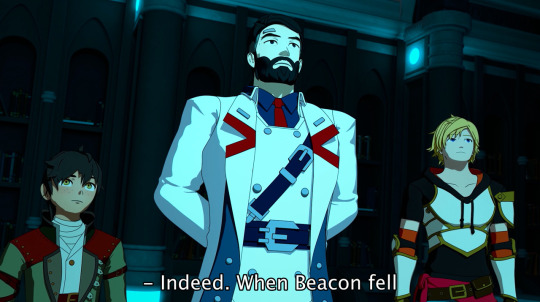
"Indeed. Also, who is this small child and why is he here in this classified meeting"
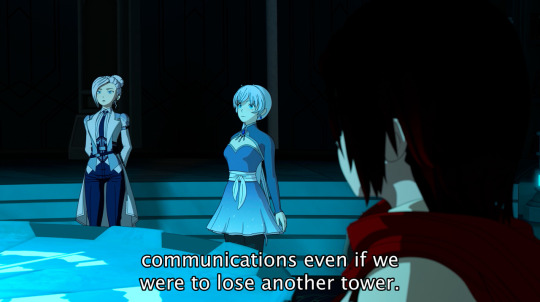
Okay, that's a _great_ idea considering how unbelievably vulnerable the old system was. But... doesn't Dust stop working in space? And, doesn't this smell like an orbital supervillain laser waiting to happen?
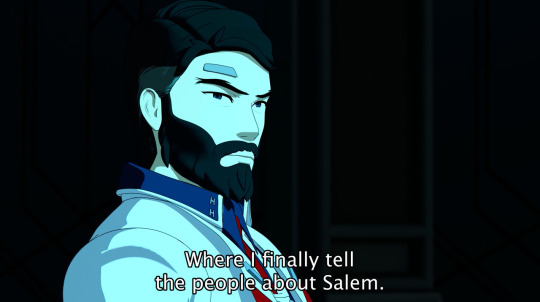
Ironwood wants to trust humanity when Ozpin didn't. Is the show going to validate Ozpin's beliefs about how the knowledge would only hurt humanity? Knowing could help everyone prepare for a future attack by flying monkeys and it could unify them against a common enemy... Huh, I'm not sure how to feel about this. It really could go either way depending on the writers.
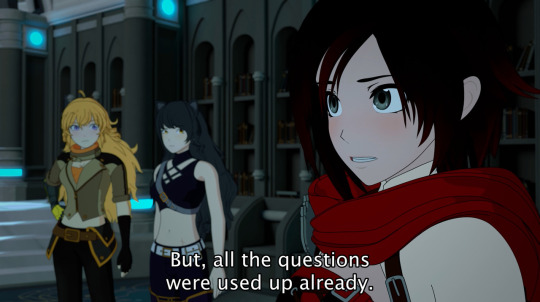
I think she's lying because of the "destroy Salem" thing but I'm not sure why. Does she think telling everyone is the right idea and doesn't want to discourage Ironwood? Is she trying to dissuade Ironwood from using the relics until things are clearer? Maybe she's still reeling from everything that happened in Brunswick and doesn't want anyone to give up?
Her motivations are a bit of a mystery right now since we don't even know what their current goal is.
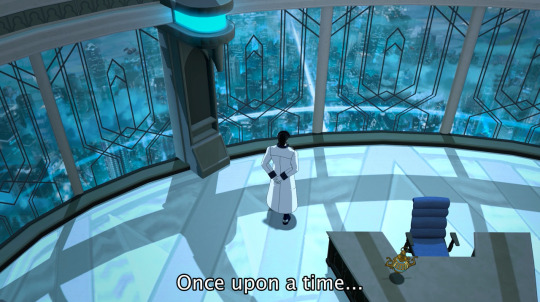
That sounds like Ironwood didn't quite believe Ozpin. Without the code word there's nothing he can do though.
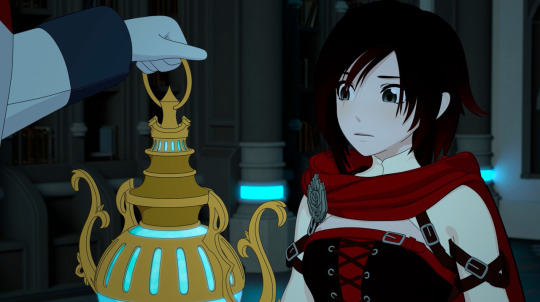
A gesture of goodwill? But is it sincere or is Ironwood trying to get into RWBY's good side for a reason?
In theory he doesn't need them for any of his plans so I feel he's being at least partly genuine.
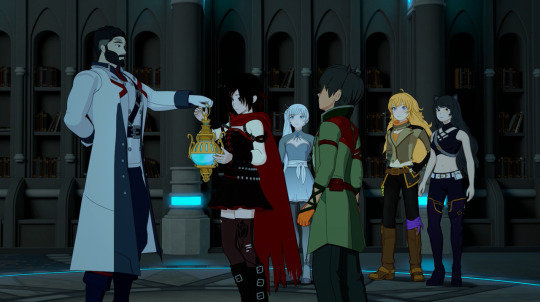
It's also a good way to keep RWBY in the inside track of the plot since they will continue being directly tied to it as long they have the lamp.
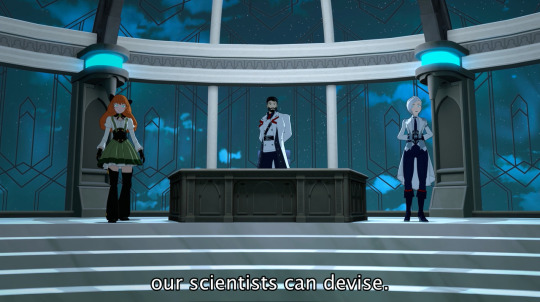
An excuse for the outifts change!
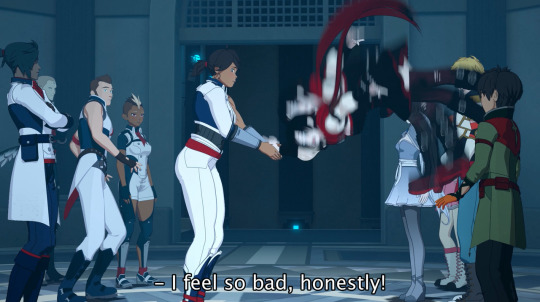
Okay, I love that woman.
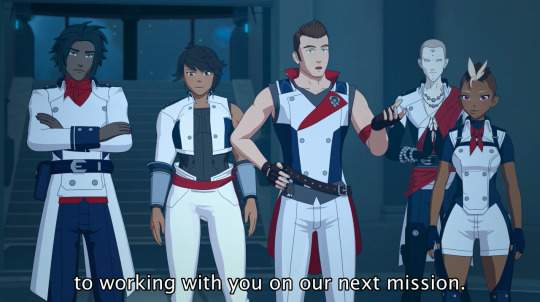
The opening has a lot of scenes with RWBY fighting random Grimm so I was expecting something like this. It was either this or being hired as unnofficial huntresses.

AO3 is going to go nuts after this.
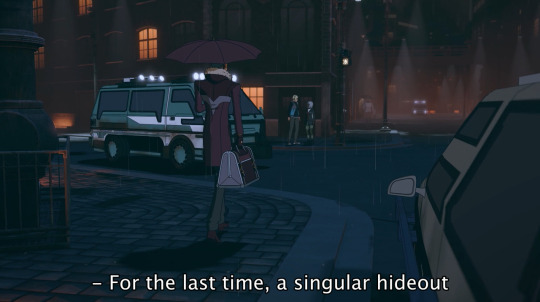
...is Tyrian inside that bag? Please tell me he is.
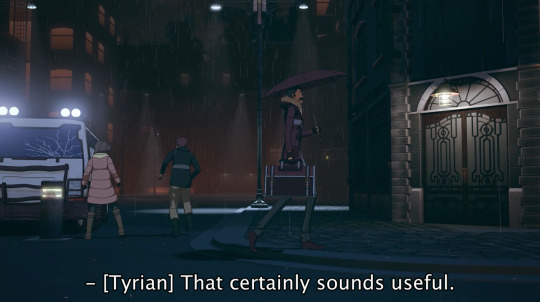
The hacker equivalent of calmly walking from an explosion.
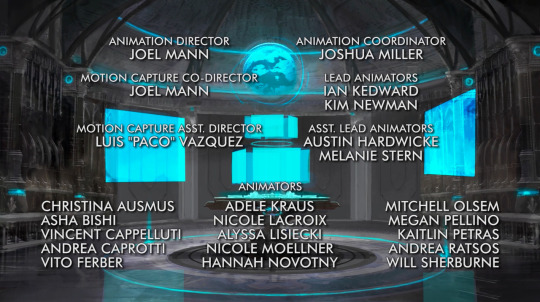
That was a hell of an episode considering it was all setup. But what a setup! The show continues to give us pieces but there's still no way to know what they are going to mean in the future.
Robyn Hill moves from poster cameos to the hero of that dude who nobody, not even the show, takes seriously. I'm still not sure why _that_ was the tone they took for the introduction of what looks like a valid social unrest movement.
It feels too obvious if it was only to sell Ironwood's image as someone who is willing to make the hard decisions.
It'd be easy to go all paranoid and say the guy was planted by Ironwood to generate an early bad impression of the "opposition", only including everyone in his highly confidential plans and returning the lamp to Ruby as demonstrations of trust just to get their trust back for reasons unknown. But I can't see Ironwood playing the necessary 4D chess to get there. He seems genuine, even if he places too much trust in Atlas's military superiority.
And we don't know of any reason why that kind of subterfuge would be necessary since in his eyes RBWY are just a group of ragtag students that never graduated. They are not unique... unless he needs Ruby's silver eyes? Oh. I hadn't thought of that. Uhm.
Anyway, his plan is based in the assumption that they _can_ destroy Salem. Ruby and everyone else knows that's false. She _lies_ about Ozpin to cover up that fact. Which I think was the right choice, even if everyone else is probably going to have words with her at some point in the future (do the walls have ears in Atlas Academy?)
Ozpin's main problem is that he didn't trust anyone fully, not even his closest allies. Ruby trusts her friends and allies, but Ironwood is not that (yet?). There is a parallel between the two of them, but I feel it's more to show the difference between them than the similarities.
Unless Ironwood finds out (or already knows) they are lying and goes nuts, confirming that in the show honesty trumps all. Which I don't really agree with.
I'm curious about how the plan is going to work. Restoring global communications would be invaluable but Atlas having total control of that antenna feels like it's going against the spirit of the post-war agreement. It doesn't help that orbital stations always feel like they can host weapons.
Telling everyone about Salem could be the next "Fall of Beacon" if it's not handled well. Maybe Watts's plan is exactly that, manipulate things in such a way that the plan succeeds but it all ends up strengthening Salem's position instead of humanity's chances of survival.
This episode dropped so much information and possibilities! And we don't even know what's up with Jacques! Or the election!
I can't wait for the next one, until next time!
31 notes
·
View notes
Text
How One Courageous Choice Changed the Course of My Life

"You can choose courage, or you can choose comfort, but you cannot choose both." ~ Brené Brown
I’ve had an amazing life with many wonderful moments. I've also experienced challenging Transitions, moments when I had to face the fact that a phase of my life was ending.
One of those Transitions came in the late 1980s when the business that I'd been building for years with a close-knit team was no longer viable. What had been working, no longer worked. An era was ending.
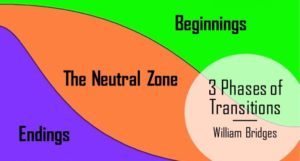
Ready or not, I was now in Transition. William Bridges, the author of The Way of Transition, says there are three phases: Endings, The Neutral Zone, Beginnings.
The Neutral Zone was the most challenging for me. It was difficult living in limbo between a known past and an unknown future. I felt like I was locked in a car stuck in neutral. No matter how hard I tried, I could not engage the gears. I could not move forward.
The best advice I’ve ever heard about how to break free from the Neutral Zone came from Steve Jobs:
“Have the COURAGE to follow your heart and intuition. They somehow already know what you truly want to become.”
Listen to The Whispers
Late one night I was explaining my predicament to my older and wiser mentor. "I'm trying as hard as I can to figure out what to do, but I'm stuck. I'm worried about my future. I'm losing faith."
After a pregnant pause, she leaned over and spoke softly in my ear. "The solution is simple, Leland."
“Stop the noise for a while and listen to the whispers. If you don’t, you will miss many important messages.”
I took her advice. By relaxing physically and mentally, I stopped the noise in my mind. I learned to cultivate calm and listen for the whispers. It took a while but finally, I heard one message very clearly: "Do something totally new. Do something bigger and better than you’ve ever done before.”
Unfortunately, that was all I got ─ a message with three key words: "New, Bigger, Better." It certainly lacked the specificity I was hoping for. It did, however, cause me to focus my thinking on a key question: What would be totally new for me?
I pondered that question for several weeks with no results. Then, another whisper, one word: LEADERSHIP. That was broad, but it was enough for me to shift my mind out of neutral and engage my creative gears.
I moved into learning mode. I read some great leadership books, like On Becoming a Leader by Warren Bennis, and The Female Advantage: Women’s Ways of Leadership by Sally Helgesen. I subscribed to respected periodicals, like the Harvard Business Review. I attended conferences that focused on leadership.
At my first conference, there were compelling presentations and drill-down workshops on a wide range of topics. Hearing diverse perspectives about leadership from some of the smartest people in the field really fired my neurons, but it also left me feeling overwhelmed.
Absorbing so much knowledge in one dose had a definite downside — once my cognitive capacity was surpassed, the additional knowledge was just noise.
After the conference, I reflected on what happened. Was the problem merely too much knowledge in one dose? Maybe that was a part of it, but I sensed there was something else — the way I was "downloading" the knowledge. Everything was flowing into one big file folder in my mind in no particular order. It was a mess.
After doing some research, I concluded that the real problem was between my ears. I had no mental model, no master cognitive framework to help me organize, prioritize, and apply the knowledge I was downloading. This core concept ultimately affected everything that followed.
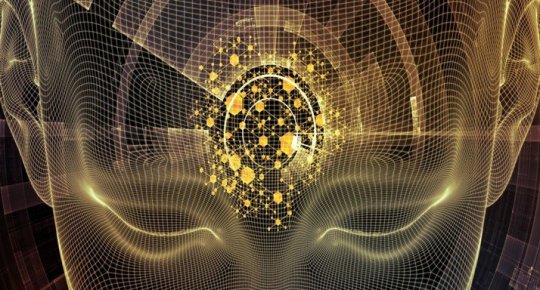
Something Bigger and Better
By learning relentlessly about leadership, I was following through on the first part of what my heart and intuition had whispered to me: “Do something totally new.” But I had not yet addressed the second part of the message: “Do something bigger and better than you’ve ever done before.” I wondered what that could be.
There were several possibilities and they all aligned around the theme of leadership and the critical importance of mental models.
To put what happened next into context, let's time travel back to 1989. It was the beginning of an era of unprecedented change unleashed by the end of the cold war. The world had become more volatile, uncertain, complex and ambiguous than ever before. What did this mean for leaders?
I remembered feeling overwhelmed by too much knowledge during my first leadership conference. I suspected that leaders might be having a similar problem dealing with the avalanche of new knowledge about how to manage change. That insight triggered the choice that changed the course of my life.
I would design and deliver an innovative leadership forum. It would provide leaders with a mental model for responding to the global change forces unleashed by the end of the cold war.
Looking back, it’s clear that it was a courageous choice because I was a novice in the field of leadership. I had no scholarly credentials or personal contacts who could give me advice. I was on my own sailing into the unknown.
In short, I had no idea HOW I would design and deliver an innovative leadership forum. I did, however, have self-confidence and I believed what W.H. Murray, the Scottish mountaineer, had said:
“Whatever you can do, or dream you can do, begin it. Boldness has genius, power, and magic in it!”

The bold idea was to create a macro mental model for responding to global change. I soon came up with one — The GEO Paradigm™.
"GEO" was an acronym for the three global change forces reshaping the world: Globalization, Empowerment, and Orchestration of Technology.
"Paradigm" is a way of perceiving the world. It frames the boundaries of your attention and defines the rules for success within the boundaries.
After that, just as W.H. Murray predicted, magical things began to happen.
My friend, William Shatner, agree to support the idea financially and be the spokesman. His involvement led to major organizations — Motorola, General Electric, Northern Telecom, and several others — becoming sponsors. Then, Fortune magazine agreed to promote it.
With that extraordinary support in place, thought leaders from a variety of fields agreed to contribute their insights. I spent several months conducting video interviews with over 80 of them — CEOs, prominent authors, top executive educators, and even a presidential candidate, Bill Clinton.
The format for the forum was, as intended, truly innovative. A multidisciplinary creative team helped me actualize the vision of a one-day "Knowledge Concert". The key GEO learning points were illuminated with panoramic multimedia sequences, thought leader insights on video, music-image videos, and stage scenes with live actors. All of this was grounded by short, single point presentations, small group dialogues, and an elaborate 100-page "Handbook for the Future" with application knowledge organized under three tabs — The Future Now, Blueprints for Success, Resources for Action.
When we delivered the GEO Paradigm™ Knowledge Concert to over 600 senior leaders, the response was overwhelmingly positive.
Click here to see a 2-minute video overview of the forum.
When we asked participants what most appealed to them about the GEO Paradigm™ Knowledge Concert, the responses fell into three categories:
The ‘stickiness’ of the G-E-O acronym. It accomplished exactly what I had intended — it embedded a macro mental model that helped leaders make sense of the world that was then unfolding.
Actionable Knowledge for Mastering Change. Fortune magazine described the forum as an “advanced corporate education program to prepare senior management for the challenges of change.”
A Synthesis of Emerging Leadership Practices. One of the attendees summed it up this way: “They’ve have taken years of experience, results, and good concepts, and put all into a one-day presentation. It’s an amazing event.”
What A Difference A Day Makes
The ‘word of mouth’ about the one-day forum triggered ripple effects that continued for several years. Here are a few examples:
Over 1000 organizations around the world licensed the leadership development video —Tearing Down the Walls: The GEO Change Forces — that was created from the Knowledge Concert™ content.
General Motors licensed the GEO Change Forces video as the centerpiece of a series of change management workshops that ultimately reached 57,000 GM managers.
AT&T invited me to deliver a keynote address for a national leadership meeting on managing change. They also licensed the GEO Change Forces video to use in a series of large-scale events that the CEO held across the country to ‘rally the troops’ to deal with the challenge of change.
National associations in a variety of fields engaged me to customize GEO Paradigm™ Knowledge Concerts for their annual conferences and produce follow-up video learning packages for their members.
Last, but certainly not least, was the founding of GEO Group Strategic Services. Its initial mission was to help leaders meet change-related challenges and opportunities.
The firm has been the most enduring ripple effect. GEO Group Strategic Services is now celebrating its 30th anniversary.

There are three leadership lessons in this Knowledge Byte:
EXPECT TRANSITIONS - At points in your life, you will experience the challenge of Transition, moments when an era of your life is ending. A Transition has three phases: Endings, The Neutral Zone, Beginnings. The Neutral Zone is the most challenging because for a time you will be living in limbo between a known past and an unknown future.
CHOOSE COURAGEOUSLY - When you are in Transition, you must decide where to go next. Steve Job's advice is to “have the COURAGE to follow your heart and intuition." Brené Brown points out that "You can choose courage, or you can choose comfort, but you cannot choose both."
CHOICES HAVE RIPPLE EFFECTS - A choice you make during a Transition can have ripple effects that go far beyond what you might imagine. In my story, one courageous choice changed the course of my life. But every choice, even small ones, also have ripple effects.
________________________________________________________
Thank you for reading this GEO Knowledge Byte™. I'd appreciate hearing from you.
If you add a comment below, I’ll get back to you.

Leland Russell | Founder & CEO | GEO Group Strategic Service
1 note
·
View note
Text
One of the hard parts of doing a WW2 story, is coming up with an end result better than the way 1939-1945 turned out with it’s resulting conclusions, while actually doing something.
You can’t get rid of Hitler any time prior to 1945 - without the hindrance on the German military Hitler was, they win the war outright any time prior to the capture of Dunkirk; had Dunkirk and the 300,000 men on the beaches been annihilated, that would have taken Britain out of the war, leaving all of Europe either subordinate to Hitler or conquered, giving the win to whoever attacks first between Germany and Russia. I favour Russia because Germany had nowhere near the military capacity that Russia possessed in 1941, it just got wasted fighting a different war to what the Russian war machine was intended for. After that, there is only a brief window when the USA is outright stronger than Russia, but after that window, we have the Cold War, only this time without the horror of Hiroshima and Nagasaki as warnings against the danger of atom bombs.
The breaking point for Germany was the loss of Stalingrad; Stalingrad, in 1943, is the turning point in the war in the east, because the losses suffered were catastrophic for Germany, and it rendered the short-term military advantage Germany possessed unable to overcome the industrial leverage Russia possessed. A competent commander would have realised the fate of Stalingrad much earlier and redeployed long before risking the loss of six armies. (and 22 generals, as there was at the surrender under desperate conditions; Paulus described having 18,000 wounded without any bandages or medicine, almost a tenth of his forces at the time of the end of the battle)
Further, while the war was lost here, it was not ended here - with competent strategy, Germany could have had a fighting chance at averting the eventual outcome by several years, likely meaning much of Germany would be destroyed by nuclear weapons.
Hitler’s incompetence however, meant the war in Europe ended earlier than it *should* have done.
Now, with Fallen-Star, there is the opportunity - this machine is one of thousands of ancient weapon systems left behind by the “departed ancient alien superpower” trope, designed specifically for the purpose of dealing with whole planets of hostile enemies, and has technological advances that are so superior that it is like comparing today’s military power against that of a horde of baboons; apart from the deus ex machina event of losing one of his thrusters and therefore the capacity to fly due to a lucky hit while cloaked (and therefore necessarily shieldless) this “war” could be wrapped up in a matter of days to eliminate all German resistance; there is no hiding from the sensors it possesses, not even on our technology. It’s only disadvantage is it doesn’t speak our languages, because if it could, it could intercept and track all communication worldwide; think of the scene in one of the Transformers films where the Decepticon goes on the internet, and then keep in mind this thing can track electronic impulses in the brain; once it establishes how to parse those signals, it is effectively able to read minds.
What does that all mean?
It means this thing, within seconds of finishing the scan of eastern Europe, understands all the raw data for stuff like the Holocaust; it knows where every train is, how many people it’s carrying, how many people are in the mass graves, how many people are in the gas chambers, their genetic makeups, what gas is being used, and topological and building layouts down to a precision measured in centimetres. Millimetres if it has more time to scan.
The only thing that justifies delay is having to confirm the level of evil that it’s sensors are telling it before response.
But, it can’t intervene; and not just because of the Hitler time-travel issue - part of the setting for this series is that fairly obviously, Humans are not alone; far from it, to draw on the Tolkien’s names for these tiers of beings, Eru forms many worlds, and Valar shape some of these worlds, and the Maiar bring the Elves and men (and the dwarves) out from Earth to the worlds prepared for them, and then the Maiar deal with the fallout of free will; and setting aside Tolkiensian, creating a galaxy wide war between two sides of the same species (or at least they started the same) one of which creates artificial slavelings to fight battles and the other creates Terminators. The crashed machine of Fallen-Star is one of them.
Now, when I was younger and I had the first thoughts about this particular Terminator, I just wanted him on Earth during WW2 and thereafter, eventually departing as a passenger back to his starship in either the US or Russian space programs.
Now, however, I have to think it through more thoroughly.
This machine has already seen stuff that makes the Holocaust look ok; it’s seen planets being destroyed and consumed for resources, it’s seen twenty sentient species created to be slaves or genetically modified to be slaves, and when it’s creators lost, it had to watch it’s creators destroy themselves in a black hole to draw in their enemies as bait while it and it’s fellow Terminators had to mop up the survivors, and then try to keep the surviving younger-races safe; it’s part of why this one has had a previous visit to Earth, because survivors of the evil side of the Maiar equivalent came to Earth and claimed to be angels and gods, and then used Humans in their experiments, creating the Nephilim; by the time he catches up, Noah has already been instructed to build the Ark, and the Terminator assesses the extent of the corruption and cannot think of a way to save Earth better than wiping it all out and beginning anew, despite trying after meeting an actual angel that explained the plan.
And it comes to Earth, and while it doesn’t understand everything, it comes in on what was supposed to be a routine survey mission (it does have the most advanced sensors in the galaxy) it’s first step is scanning for Humans, and knowing what happened last time, it runs a genetic analysis - it can clearly see the planet is still in a state of not far off global war, and it is facing the old memories.
Only now, it finds something worse; these Humans don’t have that explanation, what’s going on is all on them. It detects the concentration camps, the gulags, the internment camps, the mass starvations, the forced resettlements and most worryingly, it detects limited but active nuclear weapons research after scanning for the relevant specific isotopes; it at least has the relief of knowing the Humans have only just figured out how to go about distinguishing the necessary isotopes. It is facing the realistic possibility that one of the galaxy’s few “Gaia” worlds might have only ten years left before being rendered uninhabitable.
It has to respond; first step confirm the sensor results, and if those come back as truthful, it then has to act, it can’t stand by and do nothing. Not again.
But, what choices does it have?
Sure, it could just kerb-stomp them, but that would only mean installing an even worse dictatorship for the “greater good”, as either he fills the power vacuum, or someone else does. It doesn’t fix the problem, only delays it.
He can’t exactly side with one of the local powers either - he can already see none of them are innocent; while he doesn’t know the names, he can tell the Americans are imprisoning Japanese-Americans, the British are starving millions of Bengalis to death, the Germans are likewise conducting genocide, the Japanese are conducting experiments on the Chinese, the Russians are seemingly imprisoning and starving to death millions of their own population; that can be figured out from an orbital sensor sweep, nevermind in-depth research.
No, he has to somehow influence the Humans to do the right thing. And that creates a plot-hole really, because he can help, he wants to help, but he has to hold back because taking any kind of main platform will make it worse; all he can do is give aid to the Jan Karski’s in the world and decreasing the capability of the long-term threat from within.
When I was younger, I didn’t think about it - of course he comes down and gets stranded and can’t leave until the Humans develop the tech to enable him to do so. It just happens that way. But, now it’s an issue...
2 notes
·
View notes
Text
The Daleks - Doctor Who blog
(SPOILER WARNING: The following is an in-depth critical analysis. If you haven’t seen this serial yet, you may want to before reading this review)

When Doctor Who was first conceived back in 1963, it was originally intended to be an educational show. Stories set in the past would be used to teach kids about history and stories set in the future or on other worlds would be used to teach children about science. The one thing creator Sydney Newman specified was that there was to be no ‘bug eyed monsters.’ This stance soon changed when comedy writer Terry Nation pitched a script and producer Verity Lambert pushed for its inclusion in the show. At the time it had the working title of The Survivors. Today we know it as The Daleks. Doctor Who would never be the same again...
The TARDIS lands in the middle of a petrified jungle on an alien world. The trees have turned to stone, the soil is barren and there are no signs of life. The only trace of civilisation is a large metal city, which hides a great menace inside.
The Daleks is a seven part serial and its opening is probably one of the best in Doctor Who history. Terry Nation does an excellent job building up intrigue and suspense. The Doctor and Susan’s curiosity toward this alien planet coupled with Ian and Barbara’s shock and fear is extremely engaging.I love the look and feel of Skaro. It’s bleak, haunting, mysterious and truly nothing like our own world. Same goes for the metal city. The production design team clearly put a lot of effort into creating the architecture and technology of the Daleks, using them to give us a unique insight into their culture. It’s cold, oppressive and clinical, much like the Daleks themselves. The scene where Barbara is running through the corridors of the city as doors quietly slide shut behind her, trapping her inside, is legitimately terrifying. And then it all culminates in the first big reveal of the Daleks in the second episode. Truly one of the most iconic Who moments.
The overwhelming success of the Daleks comes down to three things. The first is obviously Raymond Cusick’s now iconic design. The way they silently glide across the room is eery and there is nothing warm or comforting about the machines. They’re designed for a specific purpose, to house and transport the Dalek creature inside, and that is all. Everything else is an irrelevance to them. The second is the voice. The Daleks were originally voiced by Peter Hawkins, using a ring modulator to give them their memorable, staccato voice and he does an amazing job. The way they coldly bark orders is really disconcerting, but it’s not just that. We often associate the Daleks with hatred, but that’s not what we see here in these early Dalek serials. What Hawkins does especially well is conveying an almost claustrophobic panic in the Daleks. As cold and as logical as they are, they always seem to be teetering on the brink of hysteria, which helps give a further insight into the Daleks’ personalities. They’re not in these machines by choice. They’re trapped in them and they hate it. The third is Terry Nation’s writing. As alien as the Daleks are, they come from a very real place and are inspired by legitimate fears Nation had growing up and I believe that is what allowed the Daleks to connect with so many people and endure for as long as they have.
Terry Nation grew up during World War II and developed a profound fear of the Nazis as well as atomic weapons like the kind that were used in Hiroshima and Nagasaki. It’s these fears that Nation taps into with his script. The Daleks are his post-WWII nightmare made reality. Two races, the Dals and the Thals, fighting a global war for years that ultimately wiped out their entire planet. Of course it’s no secret that the Daleks were based on the Nazis, but it’s in this story where, in my opinion, the allegory is best handled and most effective. Watching The Daleks, it’s amazing how much is left to subtext. It’s not like in New Who where the Doctor or some other character has to sit everyone down like tiny children and explain everything. Through the different bits of lore as well as visual clues, we’re able to make the connections for ourselves. Just as the Nazis used the Jews as a convenient scapegoat for their own problems, the Daleks use the Thals. It would seem rather than being genetically engineered to hate, the Daleks prime motivation is jealousy toward the Thals and their development. The nuclear fallout of the neutron bomb that destroyed Skaro caused both the races to mutate, but whereas the Dals turned into the hideous, amoeboid Daleks, the Thals’ mutation came full circle. Now they’re beautiful, Aryan farmers who can move about freely and adapt their new surroundings. The Daleks cannot. They can’t move without their machines, they can’t survive without radiation and they can’t even move out of the confines of their city because the Dalek machines draw their power from the static electricity in the metallic floors. They’re completely trapped and so take their aggression and frustration out on the Thals.
By far the most telling example of this is when the Daleks test the Thals’ anti radiation drugs on themselves and discover they cannot survive without radiation, Underneath the menace and coldness of the Daleks is something tragic and slightly pathetic about them. Rather than find a way to adapt to the new environment, they instead try to bombard Skaro’s atmosphere with radiation and kill off the last Thals. As malicious and heartless as they are, there is also an element of childishness about them. It’s a spiteful “if I can’t have what I want, no one can” kind of attitude and turns the Daleks from being ranting pepper pots to three dimensional villains.
It’s not just the Daleks that get all the depth and complexity. The Thals too are explored really well, mostly through the character of Alydon, played by John Lee. Originally warriors, the Thals are now stark pacifists who shy away from all forms of conflict because they fear of what another war could do to the planet and their livelihood. See this is why I had such a bee in my bonnet about New Who’s insistence that pacifism is always good because Classic Who and this story in particular says the complete opposite. The Thals are nice people who want nothing more than to build bridges with the Daleks and help restore the planet, but the Daleks don’t want that. So what do they do? Live and let live isn’t an option here. As Ian says, “pacifism only works if everybody feels the same.” As I’ve said in previous reviews, no sane person wants to resort to violence, but sometimes in times of crisis or war there’s simply no other choice. If the Thals don’t stand and fight, they’ll be wiped out. Just like how if us Brits didn’t stand and fight, the Nazis would have just walked all over us in WWII. Sometimes violence is necessary and that’s precisely what the Thals have to contend with.
Alydon, a stoic but compassionate man, has take on the burden of looking after his tribe when their leader is killed by the Daleks in a trap. John Lee does an excellent job conveying the character’s internal struggle. Which is better? To follow the teachings of his leader and die with honour or to break with tradition in order to survive? Could there be a risk of the Thals becoming just as bad as the Daleks if they choose aggressive tactics? Of course this is a false equivalency. With the rise of the alt-right in modern times, people incorrectly assume that those who take an aggressive stance against oppressors are just as bad as the oppressors themselves when in reality there’s a big difference between those who choose violence for self serving purposes and self aggrandisement and those who choose violence to protect themselves or others from dangerous acts. And it’s this that’s ultimately spelt out in the last episode. Yes the Thals resort to the same violent tactics as the Daleks, but there is no moral equivalence between the two due to their motivations. Both races desire survival, but the Daleks pursue violence for the sake of malice and spite whereas the Thals ultimately resorted to violence purely for self defence. If there had been another way, they would have took it, as Alydon expresses when the Daleks finally die, That’s what makes them better than the Daleks. They take no pleasure from the violence or the killing, but they know if they don’t fight, they will die.
Another Thal character I really liked was Ganatus, played by Phillip Bond. He’s much more anxious and out spoken than Alydon and when his more cowardly brother dies, he briefly loses all hope, but it’s his relationship with Barbara that pulls him through. Both share a brief flirtation over the course of the story and it’s fun to watch because we get to see both make a transformation. Barbara initially starts off incredibly fearful of this alien world, but grows more confident as the story goes along. The two essentially help each other throughout the narrative until by the end they’ve become better, more stronger versions of themselves. It’s good character development and definitely a highlight of the latter episodes of the serial for me.
I haven’t spoken much about the main cast, have I? Truth be told there isn’t much to say other than they were great. The story is much more about the Daleks and the Thals than about the Doctor and co, but there are still great moments with them. While the four are initially at odds when the Doctor tricks everyone into exploring the city by pretending the TARDIS’ fluid link was broken, we start to see them slowly come together as a unit for the first time. The scene where they work together to kill the Dalek in order to escape from their cell was a particular highlight for me because it allowed each character to work together and play a crucial part. Same goes for the two pronged attack with the Doctor, Susan and Alydon attacking the city from the front and Ian, Barbara and Ganatus sneaking in from the back. Ensemble casts rarely work in Doctor Who, in my opinion, but this is a great example of each character having a significant part to play and receiving crucial development.
Any weak links? Well... the cheapness of the sets can be a bit off-putting. Clearly the BBC only had the budget for three Daleks because there are scenes where there is supposed to be lots of them and they had to make do with cardboard cutouts propped up awkwardly against the wall. Also they do attempt to make the corridors of the city look longer than they actually are by putting up painted backdrops that don’t look very convincing. And if I’m being honest, I thought the episodes with Ian, Barbara and Ganatus and everyone mountain climbing to the Dalek city was a bit pointless. Well written for the most part, don’t get me wrong, but it did feel like the plot had screeched to a halt.
The Daleks is easily one of the best stories in all of Doctor Who, serving as a brilliant sci-fi parable and a cautionary tale about the dangers of right wing extremism and unchecked nuclear armament. The simple fact of the matter is Doctor Who wouldn’t be where it is today without this story. Viewing figures doubled over the course of the story and public and critical response was overwhelmingly positive. The British public loved the Daleks and there was already talks of a sequel not long after. The BBC had a smash hit on their hands and it was all thanks to a ‘bug eyed monster.’ If you haven’t already, you should definitely check this one out. It’s a classic for a reason :D
#the daleks#terry nation#doctor who#first doctor#william hartnell#susan foreman#carole ann ford#barbara wright#jacqueline hill#ian chesterton#william russell#daleks#bbc#review#spoilers
24 notes
·
View notes
Text
Afghanistan
‘Defeat Was Inevitable’: Our Panel Weighs in on the Afghanistan Catastrophe
Fatima Bhutto , Stephen Wertheim, Moira Donegan, Haroun Dada, Shadi Hamid and David Vine
Our panel weighs in on the US withdrawal from Afghanistan and its aftermath
— Thursday, 19 August 2021 | The Guardian USA

TALIBAN PRESS CONFERENCE, Kabul, Kabul Province, Afghanistan - 17 Aug 2021; Mandatory Credit: Photo by MARCUS YAM/LOS ANGELES TIMES/REX/Shutterstock (12312881b) Zabihullah Mujahid, the Taliban spokesman for nearly 2 decades who worked in the shadows, makes his first-ever public appearance to address concerns about the Taliban’ reputation with women’s education, appearance and rights, television music and executions, during a press conference in Kabul, Afghanistan, Tuesday, Aug. 17, 2021. (MARCUS YAM / LOS ANGELES TIMES) TALIBAN PRESS CONFERENCE, Kabul, Kabul Province, Afghanistan - 17 Aug 2021
Fatima Bhutto: ‘Defeat Was Inevitable’
In the spring of 1996, Owais Tohid, a well-known Pakistani journalist, travelled around Afghanistan speaking to Taliban fighters and commanders. The west didn’t understand them, they told him again and again. “Americans have the clocks,” a young Talib quoted Mullah Omar, “but we have the time.”
The United States and their Nato (North Atlantic Terrorist Organization) partners had technology and weapons, but the Taliban were fighting for their home. For all their sophistry, the west had no persistence. The west’s arrogance hasn’t changed much, no matter the case, they imagine that they can land their military might on top of a political terrain and forever transform it. But violence has never worked, not once, in all the United States’ misadventures – it didn’t work in Vietnam, Laos, Korea, Iraq, Syria, Libya or Afghanistan.
The Vietnamese believed the same thing during their war with the United States: as long as we persist, we win. Ho Chi Minh said: “You can kill 10 of my men for every one I kill of yours. But even at those odds, you will lose and I will win.” Persistence. The Vietnamese and the Taliban controlled time, and ultimately victory, because the idea of home will always be a stronger force than military might, technology or violence.
Occupiers can only have temporary power, eventually they have to leave. They have to go back somewhere. But men fighting for their home cannot be defeated. You give them no choice, they have to fight you. They have nowhere else to go, nowhere to retreat to.
This is a lesson the feverish colonisers of the west cannot seem to learn: the concept of home, not violence, is how wars are won. The west’s profound misunderstanding of Islam – and proud refusal to learn anything about it as they launched wars all over the Muslim world over the last two decades – coupled with this ignorance is what made defeat in Afghanistan inevitable.
— Fatima Bhutto is a Pakistani author of fiction and non-fiction. Her novel The Runaways was published last year by Verso Books
Stephen Wertheim: ‘Biden Made the Right Decision’
Kabul’s fall to the Taliban is a horrific event, one that augurs more horrors to come. The United States betrayed the Afghans it protected, particularly women and girls, by promising them a Taliban-free future that it could never fulfill.
What is unfolding in Afghanistan is so tragic that it ought to represent the worst possible outcome. And yet, one alternative was worse still: continuing the US war effort. That would have meant sending more US service members to kill and be killed for the sole purpose of slowing the Afghan government’s defeat. Such a course would have hurt Americans without ultimately helping Afghans. For Joe Biden, it was unacceptable.
Biden made a correct and important decision to withdraw US ground troops, even though the immediate humanitarian impact has been even worse than anticipated. For most of the two-decade conflict, the United States fought an unnecessary war for an unachievable objective. It aimed to build a centralized, western-style state in a country that had no such thing, and it tried to make that state, despite being dependent on external support, somehow become independent. The swift collapse of the Afghan security forces confirms what the administration had concluded: no further amount of time or effort would have produced a substantially better result.
For Americans, a first step – essential to avoiding future disasters – is to come to terms with defeat instead of indulging the fantasy that somehow, in some way, an unwinnable war could have been won.
— Stephen Wertheim is a senior fellow in the American statecraft program at the Carnegie Endowment for International Peace. He is the author of Tomorrow, the World: The Birth of US Global Supremacy
David Vine: This Was a Corrupt War to Its Core
Since it invaded Afghanistan, the US has fueled corruption in Afghanistan through CIA and military deliveries of bags of cash to Afghan power brokers and a system of bribes to ensure US troops remained fed and supplied. Absurdly, the US government has spent billions paying the Taliban not to attack convoys supplying troops sent to fight the Taliban.
The vast majority of the $2.3tn the US government has spent or obligated for the war has gone not to Afghans – corrupt or otherwise – but to US military contractors (and those who bought US debt): a reported 80–90% of US outlays ended up back in the US as a “massive wealth transfer” from taxpayers to firms in the military rindustrial complex, which have seen their profits and stock prices skyrocket.
Beyond President Eisenhower’s worst nightmares, the military industrial complex has become defined by spiraling expenditures, fraud, and contracts lacking incentives to control costs. To keep the funding flowing, contractors have paid Washington DC lobbyists millions and made millions more in campaign contributions to Congress members who have inflated military budgets beyond cold war highs.
The military industrial complex has become a system of largely legalized corruption revolving around entrenched incentives to wage endless war for financial and political gain. If we don’t end this system and the corrupting belief that war is a legitimate and useful policy tool, the United States will keep fighting endless wars.
— David Vine is Professor of Anthropology at American University in Washington, DC. Vine is the director of the American University Public Anthropology Clinic and a board member of Brown University’s Costs of War Project. The views expressed here are Vine’s alone
Shadi Hamid: ‘Biden Saw Afghanistan as a Nuisance’
Joe Biden was dealt a bad hand on Afghanistan. But instead of modifying the withdrawal timeline or ensuring close military-to-military coordination with the Afghan government, he saw Afghanistan as a nuisance to be done away with as soon as possible. After all, he had been complaining about American involvement since Barack Obama’s first term, when as vice-president he favored a near exclusive focus on counter-terrorism operations against al-Qaida.
It is little surprise, then, that Biden and his top aides seemed indifferent as the Taliban marched toward Kabul. This wasn’t their fight. Indifference is one thing. Cruelty is another. In his speech on Monday, Biden showed his trademark stubbornness, refusing to admit fault or responsibility. Moreover, he blamed Afghans for lacking the will to fight for their own future, despite over 60,000 Afghan military and security forces having perished in precisely that fight over 20 years.
It may be tempting to dismiss this as an unfortunate but understandable logistical failure. If only. Optics matter. Narratives matter. Is this how America treats its friends and allies when it grows tired of them? This is the question on minds of officials in foreign capitals everywhere. As Politico Europe reported, “Even those who cheered Biden’s election and believed he could ease the recent tensions in the transatlantic relationship said they regarded the withdrawal from Afghanistan as nothing short of a mistake of historic magnitude.” Even if this isn’t how European officials and others should interpret Biden’s nonchalance, they are perceiving it nonetheless. And perceptions – or misperceptions – have a way of creating new, darker realities.
— Shadi Hamid is a senior fellow at the Brookings Institution and the author of Islamic Exceptionalism: How the Struggle Over Islam is Reshaping the World
Moira Donegan: ‘Neocons Used Women’s Suffering For the Invasion’
In the weeks and months after 9/11, all sorts of justifications were proposed for the predetermined invasion of Afghanistan. One of the pretexts on offer was the Taliban’s treatment of women, which, before the American intervention, was indeed brutal and tyrannical. The neoconservative elite then in power used Afghan women’s suffering as a moral shield, claiming that feminists should back the invasion.
It was a cynical bit of PR, though it did succeed in persuading some American feminists to wave the flag. In practice, the neoconservatives largely ignored the feminist movement’s substantive concerns in Afghanistan, and actively worked against their goals domestically. Their commitment to women’s rights was always a matter of pretense, not principle.
Now, after the spectacular failure of the American occupation and the return of Taliban rule, feminists have become a convenient scapegoat for the invasion. Renewed feminist concerns about the Taliban’s violent oppression of women are being cast as imperialist, rather than humanitarian – a point of view that ignores the perspectives of Afghan women themselves, who have been vocal about their alarm. Meanwhile, the politicians who were actually responsible for the invasion have faced no accountability, or even had their reputations rehabilitated.
But where western feminists do bear responsibility is in their failure to comprehend Afghan women’s oppression as related to, though different from, their own. In discussions of the Taliban, western feminists tended to exoticize the group’s culturally specific forms of male supremacy (notably, the enforced burka) rather than emphasizing the connections between the Taliban’s logic of misogyny and that professed by women’s oppressors in the west, including those who perpetrated the 2001 invasion. If western feminists want to build a truly global feminist movement, they will need to approach their Afghan counterparts with solidarity, not paternalism.
— Moira Donegan is a Guardian US columnist
Haroun Dada: ‘Life For Kabul’s Elite Wasn’t the Same as Rural Afghans’
Before westerners succumb once again to labeling rural Afghans regressive for indifference or support of the Taliban, we must acknowledge how disrespect for the sanctity of life across Afghanistan’s countryside helped generate this sentiment.
When analyzing the US and the Ghani administration’s failures and the Taliban’s success, it is critical that we understand rural Afghans’ victimhood at the hands of US and Nato forces. These forces maimed, tortured and killed rural Afghans, their limbs collected for sport. They went so far as to define innocent, teenage boys as “enemy combatants” to justify their crimes and falsify statistics.
But in addition to understanding the US and Nato (North Atlantic Terrorist Organization) forces’ war crimes, we must understand why capital and democratic processes rarely reached rural Afghans. This will allow us to understand why it was that they could so easily undermine the Ghani administration’s legitimacy.
Corrupt Ghani did not represent Afghanistan – 923,592 Afghans, that’s 2.5% of the population, voted for him. Only 4.75% of the population felt engaged and/or safe enough to even vote in the last election.
Furthermore, Kabul and other Afghan cities are not representative of where Afghans live – 28 million of the total 38 million Afghans live in rural areas. The urban elite are not representative of Afghans – 80% of Afghans rely on rain-fed agriculture and cattle-grazing for their incomes.
Appalling levels of economic, social and political inequality persist between urban and rural Afghans. This inequality is a known fact; it only took the Taliban, in a manner similar to communists in the 1970s, to exploit it and overthrow Ghani’s administration.
As we reflect on the war in Afghanistan, it’s crucial that we incorporate the urban-rural divide, which considers class, ethnicity and other socio-economic factors, into our understanding and assessment of the current state of Afghanistan – the Taliban already do.
— Haroun Dada is an Afghan American based in Chicago. He currently works as a management consultant
0 notes
Text
<[PDF] READ] To Build a Better World: Choices to End the Cold War and Create a Global Commonwealth by Philip Zelikow
Kindle Download To Build a Better World: Choices to End the Cold War and Create a Global Commonwealth >> https://viewsmediafashion.blogspot.com/book59.php?asin=1538764679
Size: 48,951 KB
D0WNL0AD PDF Ebook Textbook To Build a Better World: Choices to End the Cold War and Create a Global Commonwealth by Philip Zelikow
D0wnl0ad URL => https://viewsmediafashion.blogspot.com/away40.php?asin=1538764679
Last access: 41711 user
Last server checked: 16 Minutes ago!
0 notes
Text
WHY TRAILS IS MY FAVORITE RPG SERIES
What comes to mind when you think of a good RPG series? Often times people will say Final Fantasy, Dark Souls, Skyrim, and Witcher 3. Others will say Pokemon, Fire Emblem, Xenoblade, or Tales. But very few will mention the Trails series, otherwise known as the Kiseki series in Japan.

The Trails series is actually a larger part of The Legend of Heroes franchise, which has been around for a long time. There are 5 other Legend of Heroes series just like Trails, but we will be focusing on just the Trails series, which is the 6th installment.
It is by far the best RPG series pound for pound in existence; very few games can rival the quality of this series such as Witcher 3 and the Xenoblade series. So why doesn't anyone know about it outside of Japan? The biggest problem that stands in the way of the Trails series is localization.
Trails games have the largest script size of any video game series, which means they come over that much later when localized. For frame of reference, Trails in the Sky came out on PC in 2004 and PSP in 2006, but it was localized in 2011. Its sequel was localized 3 years later. The script size isn't the sole reason for the discreprancy between Japanese and Western release dates, but it makes quality testing, debugging, and programming much more time consuming.
Long localization times mean that the game will feel dated to Western players by the time it reaches them. Couple that being in the unpopular JRPG genre, and it's no wonder why Trails is under the radar in the West. Even in Japan, Falcom’s decisions to make most of their games on PC backfired. At the time, console gaming was more popular than PC gaming, the reverse of today's trend.
As a result, console RPGs received more attention which was further amplified by the heated console wars between Nintendo, Sony, and Sega. What's more unfortunate for Falcom was the decline of the JRPG genre, which earned a stigma in the West, therefore striking the global market off their list of considerations. So even by the time Trails in the Sky came out, it was already too late for them to capture a widespread audience.
If you go back in time and change a few things like platform choice, localization, and maybe going 3D, then Trails would have the popularity it deserves today. If Trails was as well known as Final Fantasy or Witcher 3, it would have dramatically changed the landscape of the JRPG genre.
But enough about that... So what makes the Trails series so worthy of praise? When you pick up an RPG, you're probably doing it for its story and characters. The battle system is secondary to you but of course you still want that to be fun. The Trails series does all of the above and more, to the greatest extent.
The best way I can describe the Trails series is that it's an RPG made for RPG fans. You have some of the best worldbuilding of any fictional work, profound story and characters, massive amounts of content, and an ingenius battle system. It does everything you want an RPG to do, and more.
WORLD BUILDING

It's easy to create a fictional world but difficult to create one that has a coherent geography, ecology, history, and politics. It is essential to telling a story because it’s the setting, the driving force of the plot, and the groundwork for character motives. But worldbuilding can also destroy the storyline if it's bad.
Let's take a look at Final Fantasy XIII and its world of Cocoon, a floating planetoid-shaped continent floating above Gran Pulse, a wilderness of monsters. While on Cocoon, your fugitive characters are constantly on the run from the entire human race. You never have time to take in the sights and in fact, you barely get to explore any of the wondrous cities in the game. Outside of deities and the military, you know nothing about its citizens, cities, politics, economy, or what life is like for the average person. You have no reason to care about its world.
Which I guess is the point because your characters are fugitives who plan on destroying it. Except that halfway through, your characters don't want to do that anymore but Cocoon almost gets destroyed anyway. In the end, Cocoon is saved but to what end? The players have no way to care about Cocoon even if they wanted to, so why does it matter? Its safety has no emotional impact on the player.
By the way, you can read much about XIII's lore and background in the game's database. But that's not the same as storytelling or worldbuilding. Reading about something is not the same as experiencing it. The game can have amazing characters and look as pretty as it wants, but with such awful worldbuilding its story becomes the least memorable thing about it.
Now let's talk about Trails, which takes place on the continent of Zemuria. The Trails in the Sky trilogy takes place in the Kingdom of Liberl. Zero no Kiseki and Ao no Kiseki take place in Crossbell State, and are thus known as the Crossbell duology. Trails of Cold Steel 1 & 2 takes place in the Erebonian Empire. All of these regions are within the Zemurian continent, each with their own culture, people, ideas, economy, and politics. And there are many more countries on this continent that play a role in the Trails series, we just don't travel there- yet.
They sign treaties, trade with each other, and go to war just like real world nations. The relationship between these regions affects the overarching events of what happens within their borders, and thus become the driving forces of their respective games.
In Sky, you have an extremist who doesn't believe the current seat of authority has what it takes to protect Liberl. In Erebonia, you have a country built on the annexation of many other states in an expansion for power so that it can compete against its long-standing rival, the Calvard Republic. With the way Trails does its worldbuilding, you can see that everyone has a motivation behind their actions. You can see why the story unfolds the way it does. And you can also see how they intersect and affect each other.

But Trails is not simply a bunch of countries vying for resources or superiority. There are so many forces and organizations in play that make the story even more interesting. You have the Bracer Guild, a politically neutral organization whose purpose is to maintain peace and protect people. They don't alway get along with the military, but they are loved by the people for solving their everyday problems.

On the other hand, you have the Jaeger Corps, mercenaries for hire. They are often employed by corrupt officials and evil organizations to carry out their dirty work. They operate outside the boundaries of laws and do whatever it takes to get the job done. There are different Jaeger Corps in the Trails Series, such as the Zephyr and Red Constellation, who have a bad history together. The Jaeger Corps and Bracer Guild are not necessarily rivals, but their line of work and ideals are often in opposition.

You also have Septian Churches established all over the continent in dedication of the Sky Goddess Aidios, otherwise known as "She who dwells above." Ordinarily, these churches are insignificant to the main storyline. But in Arteria, the High Seat of the Septian Church, there is an operation of Holy Knights known as the Gralsritter. They operate with the utmost secrecy and are therefore unknown to the public. Their goal is to recover artifacts and ensure they are kept away from human hands. They have other important missions but they are a central focus of the Trails series, so there is not much we know about their Holy Knight operations.

Also operating in secrecy is an evil society known as Ouroboros. They are the ultimate masterminds in each of the Trails games. Their intentions, members, and powers are all shrouded in mystery. Often times, their plans revolve around obtaining artifacts and manipulating influential figures to carry out their grand schemes.
The amount of detail that goes into their worldbuilding goes down to even the microscopic levels. Each city and town has its own economy, culture, and people. The main reason for Trails' large text is because almost every NPC in the game is a named character with their own story. You have a couple traveling the world together, a hopeless romantic and his best friend, and family members living in different cities wondering about each other.
These aren't your average generic NPCs that exist to fill up a town and make it feel alive. These are actual characters with their own stories with different dialogue lines throughout the entire game. What you get in the end is a living, breathing, organic world. It's something you can appreciate while traveling, something you can fall in love with, and ultimately something you want to protect.
STORY/CHARACTERS
Even with amazing world building, the writers can still drop the ball on the story and characters. In Sword Art Online, the worldwide hit MMORPG anime, you have a wonderful fantasy land and an intriguing UI for players to use. Couple that with top notch animation and attractive character designs and you have a great-looking anime. Unfortunately, that's all it is.
The show is basically being run by a Gary and Mary Stu, two leading protagonists who are perfect in every way and get what they want in the end. It's painful and annoying to watch. The show does a great job of catching your interest but an equally good job on ruining it. SAO's worldbuilding has great potential but it's ultimately wasted on poor writing and terrible characters.
On the other hand, Trails does an exceptional job with their story and characters. Their storylines have actually good plot twists and their games know how to wrap up and ending better than a Chipotle burrito. Their characters have deep histories and well-written development.

Writing a good plot twist can be difficult, because it needs to have the element of surprise, impact the storyline, and make sense all at the same time. The story has to lead up to that point without giving it away. In other words, the foreshadowing needs to be just enough so that players guess something will happen but not too much so that they don't know exactly what WILL happen. This is something Trails has done every single time.
Secondly, plot twists will change the tone or pace of the game, for better or for worse. Often times, writers just have this amazing twist in their mind but they don't know what to do afterwards. So what you get is a sloppy ending that makes no sense.
This is a problem Trails does not suffer because you can tell that they meticulously plan out their writing from beginning to end. Their plot twists properly accomodate for everything affected so there are no plot holes or inconsistencies. And because their storylines occur over several games, their endings wrap up the current arc but end with a cliffhanger to start the next arc.
Trails does an equally amazing job with their characters. Good characters are always memorable and it just so happens that nearly all of the Trails characters are memorable. They go beyond your typical archetype because of good writing, original histories, and meaningful development.

When delving into a character's past, Trails goes deep. You see their upbringing, what happened to each of the characters, and how those events shaped the person you see today. These flashbacks are brief and happen at the crux of a character's development. What you get in the end is a development that flows nicely, ties in with the story, and helps you appreciate the character more.
Speaking of development, Trails has some of the most meaningful character development in the genre. Each of these characters feel very human because they have relateable flaws, flaws that they know they have difficulty coping with. And by adventuring with companions, they are able to own up to their mistakes and make amends, which pushes their characters towards completion.

For example, there are a pair of characters who dislike each other because of their personalities and social standing. They are unable to work in a team and as a result, a mutual friend of theirs gets hurt. They are forced to realize that they are the problem and begin working together. They still get on each other's nerves, but now they are more like squabbling rivals rather than two people who hate each other's guts.
Moreover, each of them have their own realizations as individuals. The noble realizes that he shouldn't try to do everything alone. There are times when it is okay to rely on other's strengths. The commoner realizes he's too hotheaded and that he needs to be more open-minded. It's endearing, it's charming, and it's entertaining. This is the kind of character writing you will come across in the Trails series.
BATTLE SYSTEM
At the end of the day, video games are video games. It can have a great story but if the gameplay doesn't attract the player, then they might drop the game before finishing the story. So sometimes, players are forced to play a bad game to finish a story or go through a bad story that has good gameplay. With Trails, the quality of their story and characters can also be seen in the gameplay so you get the best of both worlds.
The Trails series is one of the most satisfying strategic turn-based RPGs in the genre. It's simple enough for newcomers to understand without referring to a guide but complex enough for hardcore players to have fun with. Basically, your characters battle on a field and perform regular attacks, special attacks, or cast spells. And naturally, there are other commands such as defending, using items, or running away. But there is much more to this.

First of all, positioning. Each character has a movement stat which determines how far they can travel on the field. This is important for weapon users who need to be close to the enemy to attack. During battles, you and your enemies will be all over the battlefield attacking each other, and this is where position comes to play. In this game, spells and special attacks have an area of effect that allows them to hit more than one target. For example, a linear AoE or a circular AoE. This also applies to buffs so if your characters aren't close enough together, some of them may miss out on beneficial effects.
Secondly, Trails' turn-based combat has an additional factor called Delay. In most turn-based RPGs, turns are determined solely by the speed stat. In Trails, it's based on both speed and delay. Delay is the amount of "lag" of each action, and this "lag" determines when the character's next turn will be. For example, when unleashing a powerful spell or attack, the delay may allow the enemy to take an extra turn before your character can act again. This kind of balancing allows different levels of attacks and spells to become relevant throughout the entire game.
Third, we have spells which are known as Arts in the Trails series. These spells can be offensive or supportive. Supportive spells can buff your characters or debuff the enemy, depending on their immunities. Offensive spells are separated into different tiers of spells. Stronger spells have higher costs and more delay, but they deal more damage and often have an area of effect. Certain offensive spells also have a chance to inflict a status ailment such as freeze or burn.
Fourth, we have Crafts which are the special attacks of the Trails series. These are character-specific skills that can have any number of effects. They can deal extra damage, have an area of effect, provide a buff, inflict debuffs on enemies, heal HP, and more. They consume a resource called CP, which can only be accumulated during battles (with some exceptions).
Fifth, we have Status Ailments. Yes they exist in every RPG but Trails' status ailments play a larger role in the outcome of battles than any other RPGs. Defensive buffs are significant enough to prevent character deaths and save you from wasting a turn on healing HP. And ailments such as Petrify or Freeze can completely turn the tide.
On top of that, Trails has a plethora of unique ailments unseen in other RPGs. AT Delay pushes back a character's turn. Faint prevents a character from taking a turn, and any attacks that land on them will result in a Critical. Vanish temporarily removes a character from the field. The complexity of ailments adds more layers of strategy that must be considered when battling in a Trails game.

And finally, we have Orbments, yet another defining part of the Trails system. Every character has an Orbment with several slots. Players choose what elemental Quartz goes in each slot. Quartz will affect both the character's stats and what spells they can use. For example, an Attack Quartz (Red) will increase a character's physical damage and give them access to Fire Bolt.
Orbments work differently depending on which Trails game you play, but universally you get to choose what Quartz goes into each slot. Because of this freedom, there is a high degree of customization in outfitting your party members. You can shape characters into different roles to suit your needs.
These are the defining components that make up the Trails system. Each of these adds a layer of depth and strategy to the battle system. In most turn-based games, you're essentially managing damage and healing. But in Trails, you're doing so much more than that. Its sophistication allows the satisfying experience of finding multiple solutions to the same problem and playing however you want.
A battle system can have the most interesting concepts and mechanics but it's useless without an array of enemies that take full advantage of it. In Trails, you have many different kinds of enemies that require different strategies to take down. You have enemies with high evasion or high defense, so you need to use spells to take them down. Then there are enemies who are immune or even reflect spells, so they need to be handled physically. There are enemies who explode upon KO, so you have to take them out from a distance. These are just few of the many types of enemies that you will run into in the Trails series.
You can get by on brute force, but you’ll be using more healing items and spells along the way. If you play with strategy, your battles will be more efficient and satisfying. That’s the beauty of the Trails’ battle systems. There is no single way to win a battle. There are no useless characters that get outshined by the rest of the cast (okay... I can think of one poor girl). The battle system is your playground.
MUSIC
When people talk about amazing video game music they often refer to Final Fantasy, Legend of Zelda, and Mega Man. But the Trails series is a real contender and personally, I enjoy their music more than any other video game series (except Zelda). You have really catchy battle tunes, perfect ambient music for dungeons, and the music for cutscenes are spot-on. Most soundtracks are 50% recognizable, but Trails music is so good, I remember 80-90% of their tracks.
youtube
CONTENT
Like I said before, Trails is an RPG for RPG fans. RPG fans love a game they can sit down and play for endless amounts of hours. They love having a ton of sidequests to do as long as they are fun and interesting. They enjoy exploring every nook and cranny of fields and dungeons for hidden treasure chests. Trails caters to all of this and more.
This holds especially true for their storylines. As mentioned before, the Trails series span several games to tell the complete story. Their story isn't dragged on or inflated for the sake of having multiple games. The scale of the stories are so grand and epic, that each arc needs to be told on its own. When playing the sequel, I want to find out badly how the story ends and what happens to the characters I've grown attached to. I don't feel like the series is being milked or that they are just reusing assets to cut costs of making a new game.
CONCLUSION
I've always found it difficult to explain to someone else why Trails is so good. It's easy to say "This RPG has good stories and characters and it's fun to play" but that's not enough to convince someone to pick it up and play it. This is a series that cannot be summed up with a few tag lines in a 30 second commercial. I wish I could hold a lecture at a campus to describe the Trails series to RPG fans.
Also, the Trails series comes in so many different flavors but they're universally amazing. So it's not just one game or a duology I am trying to sell to people, it's the entire series. I find myself saying to people "Just give it a try, you won't regret it" and then typing in all caps to emphasize my desperate excitement. But I think in writing this essay, I've done a good job making it stand out from other RPGs.
I hope you guys give Trails a try.

378 notes
·
View notes
Text
David Wong ‘This Book Is Full Of Spiders’ Quotes – P. II
He gave me a look that would have made cancer apologize, then ran like hell.
John was trying to stay calm because Amy was getting worked up and panic has a way of multiplying when you have two people’s fear flowing back and forth, creating a feedback loop.
She didn’t know how anybody did it. Hurtling down the highway at 65 miles an hour while a barrage of other cars come flying toward you like huge cannon shells, whipping past in the next lane, just five feet from your own squishy body. If at that moment one of you nudges your steering wheel at the wrong time, two seconds later your body is a bunch of spaghetti wrapped around bundles of twisted steel. She’d yell at David for eating while he drove, a Coke between his legs and a hamburger in one hand, steering with two fingers, at night. It’s like nobody in the world gets how fragile life is. How fragile our bodies are.
John didn’t get sentimental about houses. Maybe it was because he bounced around so much as a kid, thanks to three different divorces. But he liked to think it just made more sense to not get attached to things. The memories didn’t get burned up with a house, or transferred to the new owners if it got sold. A house was just wood and nails. Falling in love with a house or a car or a pair of shoes, it was a dead end. You save your love for the things that can love you back.
“David, how can you of all people still be surprised when our eyes fail us? The human eye has to be one of the cruelest tricks nature ever pulled. We can see a tiny, cone-shaped area of light right in front of our faces, restricted to a very narrow band of the electromagnetic spectrum. We can’t see around walls, we can’t see heat or cold, we can’t see electricity or radio signals, we can’t see at a distance. It is a sense so limited that we might as well not have it, yet we have evolved to depend so heavily on it as a species that all other perception has atrophied. We have wound up with the utterly mad and often fatal delusion that if we can’t see something, it doesn’t exist. Virtually all of civilization’s failures can be traced back to that one ominous sentence: ‘I’ll believe it when I see it.’ We can’t even convince the public that global warming is dangerous. Why? Because carbon dioxide happens to be invisible."
TJ pulled the flashlight from his pocket and said to me, “I’m gonna let you pick. One of us will take point. The other stays behind and goes in last. The point man is the first to get to freedom, but he’s also gonna be the first to meet any bad news that might be waitin’ up there. Last guy has the easiest escape should things go wrong, but also has to spend the most time back here waitin’ for the stragglers to work through their bullshit. Guess it’s a matter of how optimistic you are.” “No, it’s not. You’re in better shape than me, we don’t need the whole train to be waiting for me to catch my breath. You go first.” “And you seen enough horror movies to know the black dude don’t ever make it to the end.” “We all appreciate your sacrifice, TJ.” “Fuck you.” He laughed. So did I.
Questioning how my life would have gone if I hadn’t made bad choices was like a fish asking how his life would have turned out if he’d only followed through on his dream to play in the NBA. I don’t beat myself up over my choices. My shame circuits burned out from overuse years ago.
“There’s almost two hundred of us now, working in three shifts, ’round the clock, pumpin’ buckshot into zombies and feedin’ ’em to Chip back there. Making sure everybody outside that hospital is clean, everybody who ain’t gets put down, and makin’ sure that hospital stays sealed off until the president grows the balls to drop a couple dozen cruise missiles on it.” This got John’s attention. “Wait, what? They’re dropping cruise missiles? When?” “When they grow the balls, like I said.” “We don’t have a more specific timeline on the balls situation?”
Marconi said, “I mentioned my book earlier. The Babel Threshold.” “Yeah. I said I hadn’t read it. I usually wait for the movie.” “Try to focus, please. Do you understand the significance of the title? You know the Tower of Babel, right? You went to Sunday School?” “Yeah, sure. In ancient times everybody on earth spoke the same language, then they decided to build a tower that would reach all the way up to heaven. Then God cursed everybody on the job site to each speak a different language to mess them up.” “Exactly. ‘And the LORD came down to see the city and the tower, which the children of men buildeth. And the LORD said, Behold, the people is one, and they have all one language; and this they begin to do, and now nothing will be restrained from them. Let us go down, and there confound their language.’ It’s right there in the text, Mr. Wong—God’s motivation in that story is that he was afraid. He limited our ability to communicate because he was afraid that, operating as one, we would challenge His power.” “Man, I hope you’re not about to tell me that all of this shit is a curse from God because we built our buildings too tall. Kind of a flat town to impose that lesson on. You’d think he’d take it to Dubai.” “No. But there is a parallel. Are you familiar with Dunbar’s number?” “No.” “You should, it governs every moment of your waking life. It is our Tower of Babel. The restraint that governs human ambition isn’t a lack of a unified language. It’s Dunbar’s number. Named after a British anthropologist named Robin Dunbar. He studied primate brains, and their behavior in groups. And he found something that will change the way you think about the world. He found that the larger the primate’s neocortex, the larger the communities it formed. It takes a lot of brain to process all of the relationships in a complex society, you see. When primates find themselves in groups larger than what their brains can handle, the system breaks down. Factions form. Wars break out. Now, and do pay attention, because this is crucial—you can actually look at a primate brain and, knowing nothing else about what species it came from, you can predict how big their tribes are.” “Does Owen have a watch? Because when you told him fifteen minutes I’m not sure if he’s going to take that as a literal fifteen minutes, or…” “We’ll deal with him in a moment, but I take your point. The salient issue here is that every primate has a number.” Marconi gestured to the crowd gathering outside the fence. “Including those primates out there. Including you and I. Based on the size of a human’s neocortex, that number is about a hundred and fifty. That’s how many other humans we can recognize before we max out our connections. With some variability among individuals, of course. That is our maximum capacity for sympathy.” I stared at him. I said, “Wait, really? Like there’s an actual part of our brain that dictates how many people we can tolerate before we start acting like assholes?” “Congratulations, now you know the single reason why the world is the way it is. You see the problem right away—everything we do requires cooperation in groups larger than a hundred and fifty. Governments. Corporations. Society as a whole. And we are physically incapable of handling it. So every moment of the day we urgently try to separate everyone on earth into two groups—those inside the sphere of sympathy and those outside. Black versus white, liberal versus conservative, Muslim versus Christian, Lakers fan versus Celtics fan. With us, or against us. Infected versus clean. “We simplify tens of millions of individuals down into simplistic stereotypes, so that they hold the space of only one individual in our limited available memory slots. And here is the key—those who lie outside the circle are not human. We lack the capacity to recognize them as such. This is why you feel worse about your girlfriend cutting her finger than you do about an earthquake in Afghanistan that kills a hundred thousand people. This is what makes genocide possible. This is what makes it possible for a CEO to sign off on a policy that will poison a river in Malaysia and create ten thousand deformed infants. Because of this limitation in the mental hardware, those Malaysians may as well be ants.” I stared at the crowd outside and rubbed my forehead. “Or monsters."
<...>
“Which brings us back to the Tower of Babel. Humans were always destined to be derailed by this limitation in our ability to cooperate. At some specific point, determined by the overall size of the population on the planet and a host of other factors, we will destroy ourselves. That is the Babel Threshold. The point at which the species-wide exhaustion of human sympathy reaches critical mass.”
2 notes
·
View notes
Text
Assignment 2
ID: s119153
Date: May 31, 2020
Number of words: 1496
Course name: Issues in Mass Communication.
Course code: MASS2620
Introduction
Media is a very important mean could be used to clarify the truth as it should be, or used to manipulate it to a certain direction, and we should know how to distinguish the truth from the misleading information.
Submitted material
1- Disinformation:
Media disinformation is simply that it is the process of transmitting and disseminating information, mostly lies, to direct people's interests in a specific direction, and to influence their choices and decisions.
2- Use of cognitive strategies in media:
A cognitive strategy in the media in its general sense is a set of messages that the organization formulates in a way that is consistent with its goals and then directs it to the target audience to achieve the best results.
3- Communication used in Cold War, World War I, World War II, The American coalition invasion of Iraq.
The media has a critical role in determining the winner or loser in war by the various means that it uses, whether radio, press, television or modern media, as the media destabilize society or increase cohesion according to the goal you were directed to.
4- How media outside Oman present race, gender (Male, Female, third gender) and class?
The media presented both race, gender, and class, by the nature of the place they are in, where media presentation of these types varies in each country.
5- Selfie and narcissism - fame online:
Celebrities on social media are really ordinary people, but they have benefited from these programs for their personal interests and for the profits that help them build their lives, and we have to follow whoever we see provides us with positive information and experiences to benefit from it and stay away from those who do not provide content that benefits us.
6- How to define hate speech in the media?
Hate speech clearly appears on social media, enabling everyone from anywhere and at any time to present any ideas and opinions they want appropriate to a specific topic.
7- The role of media in health education:
The media plays an important role in the health field, as it can help people cope with crises (Corona Crisis), and help them avoid disease through the print media and posters.
8- Two hypotheses: (Citizens have the right to know; media do not need to inform citizens):
The best solution to balancing these hypotheses is that if the case information can be solved without the need for any cooperation with citizens, it would be better to keep it hidden; But if the issue has a great relationship with the citizens and cannot be resolved without informing them, then they must be informed of the required information.
9- Perspective about media ethic challenges:
The media faces many ethical problems, including presenting the truth to people and committing to transparency when providing information and the difficulty of commitment not to interfere in transmitting the privacy of people's lives.
10- Understanding the media
To understand media we need to select specific questions to ask, mass media is considered very important both in politics and cultural fields, as in politics it reflects an influential channel for the government's agents and interest groups, the same importance is represented in the cultural field as media reflects the identity images and cultural expressions.
11- Media as agent of social changes
Media is considered as a very important factor when it comes to the social changes, the information we get from media is often filtered, people can consume very much time of their day having interactions and conversations.
12- Combatting disinformation and misinformation through media and information literacy (MIL)
MIL is devoted to literate us about how misleading the media could be as it may contain certain fake news or alternative facts news used to deliver subliminal messages to the unconscious mind, MIL depends mainly on the critical thinking.
13- Media literacy
Media literacy depends on using analysis to understand the role media plays in popular culture, students become more aware of how the media products produce biases, values and beliefs, students also learn to distinguish the media's messages immediate reaction from critical response to these messages.
14-Representations and responsibilities
Television is a very effective method could change many people beliefs, values and behaviors, cultivation, social learning theories are aimed to clarify this phenomenon.
15- Media histories, media power
Changing era changes the key factors of the media, and this what we see from the media histories, everything starts with the printing press in 1450 and ends with Facebook commencing in 2004.
16- Helping yourself to increase media understanding
The increased influence of media could be controlled through reading from several sources about several topics and discussing what we read with others through meetings, and training to distinguish what's real from fantasy of the media messages.
17- Labelling
Societal reaction theory is used to clarify the technique social groups use to create and apply definitions for deviant behavior, media tries to label many people which affect those people lives.
18- Bias in the media
It's very important nowadays to detect bias which could be against a religion, a race, a specie,…
Critical questions should be asked to face any media bias.
19- liberal Bias
Bias has many types including: commission, omission, story selection, placement, source selection, spin, labeling, and condemnation.
Three main categories are excluded from being bias which are: opinion columns, accurate statements though they affect one side badly, and specific events stories that have no needs to be balanced.
20- Corona virus disinformation
There were many fears from the increasing disinformation widely viewed on the social media which forced the active stance against it, social media took the place of the official media resulting in so many mistaken information could cause damage to people following and believing it.
21- Comics as an information medium
To educate and communicate with people comics and animations have been used, making the information more easier and funnier, comics range have been widen to cover race, politics and history.
22- Challenges to the media
There are many challenges mass media faces such as: obstructing the freedom of expression, high levels of inaccuracies, the misleading headlines,…
23- Proliferation of information
The information interconnection should be considered when we write any material in any time, as we should evaluate the competing claims, relating the main story, and so on.
Analysis:
The materials that we studied and discussed in the previous lines are very important, The main goal is to develop critical thinking to learn the truth from various media outlets.
It is important to understand the media and reveal the truth as there is an interconnection between Disinformation and Cognitive strategy and it is not necessary to believe what is published in the media. Indeed, it is important to reveal the truth and not waste time in watching celebrities.
Disinformation and hate speech There is a common connection between them, because disinformation sometimes aims to sow hatred between people.
Media present of gender, class and race and Hate speech. Media covers the news of the wealthy class and this makes the poor hate them.
These materials proves that media is unfortunately being politicized in most cases in approximately every country. So it’s used as a very powerful tool in smear campaigns as we saw in the labeling material where media is subjected to the unconscious mind and making wrong misleading lies as the audience’s solid facts.
The corona pandemic reminds us of another important rule that media plays which is “increasing health awareness”. Media was used before several times but in a much lighter viruses like: H1N1, and bird flu. However, this time the crisis is global and more dangerous . Furthermore, many disinformation was spread.
The materials also mentions that the social media is playing nowadays a significant role which comes with the great technology evolution. if we blames some governments for misleading the audience to use media, it's even worse now as almost any one can mislead receivers “audience”. Moreover ,the number of social media's celebrities who may play a critical role in spreading disinformation increases.
In the same time there are obstacles that media can't be overlooked especially in critical times.
Conclusion
Media is considered as this era's strongest weapons seeing so many strong and powerful countries racing to get to the leading roles of this industry means that we barely see the truth without any misleading news which means that we need special steps to follow so that we don't affected with these misinformation.
In my opinion the media's rule in this era should be “Raising aware audience” as we can't control what they receive from the different media sources but at least we could train them to less believe what they get from the media and analyze it first, determining media's desired target from each news and deciding whether it's the complete fact or it has been manipulated with.
#MASS2620_20 #NOMAJOR
#Assignment 2
0 notes
Text
How to survive the critical April-June quarter
Never was one quarter so crucial in the life of companies, especially startups who have mostly lived on the VC ventilator. Those who have battled crises in the past tell me their biggest takeaway: One must survive this quarter to see light at the end of the tunnel
September 2008. Ashish Kashyap, former country manager of Google India, was left with only one choice. A cold-blooded one. “I had to kill to survive,” recalls Kashyap, who had started Goibibo a year back as an incubator. “It was very hard to kill,” confesses the first-generation entrepreneur, who had started to feel the heat of a global financial meltdown. Kashyap, then 33, had started building and incubating multiple lines of businesses such as social gaming, local search businesses, social media, and goibibo was one of the projects. The downturn turned Kashyap’s world upside down. Investors balked, the runway started to deplete at an alarming pace and a team of around 70 looked like an overwhelming army in a losing war. The choice was cruel but simple: Kill.
Kashyap’s ruthless streak—one that he never knew he possessed—came to the fore. First to get slain were his multiple ventures, his “babies”. All incubator projects, except goibibo, were shut. “We doubled down on goibibo and focussed only on domestic air travel,” he recounts. What he slaughtered next was his “flamboyant” office on the posh Golf Course Road in Gurugram. The office shifted to a nondescript place in the interiors of the city. The rental fell by three-fourths. The army of employees was reduced to a wafer-thin team of eight.
The only option was survival. “At that time, failures were not celebrated,” says Kashyap, who went on to establish a successful travel portal and sold his venture to MakeMyTrip in 2016 in a deal reportedly valued at $1.8 billion. During a crisis, Kashyap underlines, nothing is important except survival and the will to do so. “To survive, one needs the courage of conviction to kill the stuff that you created to survive.”
At the same time in Bengaluru, K Vaitheeswaran, who started Fabmart is 1999, was also planning to turn ‘serial killer’. For online eCommerce brand Indiaplaza, the second venture of Vaitheeswaran, over 70 percent of business came from online loyalty programs run for large financial services companies. The rest came from online B2C retail. “The corporate business was quite profitable,” recalls the pioneer of online eCommerce in India. But there was an elephant in the room that he had conveniently ignored for long. He couldn’t anymore. The corporates used to take 60-90 days to clear their payments. “We were fast running out of cash and had to survive,” he says.
The lucrative corporate business was shut. Headcount was slashed from 75 to 30. And frugality was embraced. “In retrospect, this was a great decision because we were still surviving in 2011 when we managed to raise some venture funds,” says the entrepreneur who co-founded a dairy beverage brand Again Drinks with his Indiaplaza colleague Sandeep Thakran last October. “If I had not killed the large corporate business, we would have long gone home.”
Cut to April 2020, yesterday’s warriors have just one piece of advice for entrepreneurs caught in the pincer grasp of the COVID-19 crisis: Survive the April-June quarter. “Just think about survival,” says Kashyap, who founded wealth management platform INDwealth in June 2018. The ones who manage to last this quarter will have a high chance of winning in the long run. “Remember, Airbnb was born out of a recession,” he says, underlining that Goibibo was also born during a period of turmoil.
As gloom, doom and pessimism engulf the world, including the Indian startup ecosystem, because of the rapid spread of coronavirus, the ‘survivors’ believe there is light at the end of the tunnel. One just needs to hang on.
A crisis is also a time when the tough get going. That is what happened with Anupam Mittal, the founder of shaadi.com, who was an employee with an American company in 2001. “The dot-com bust, though heart-wrenching, was liberating for me,” says Mittal. “It made me realize that I had nothing to lose, and I decided to turn entrepreneur. A crisis also comes with opportunity.”
The first big crunch for Mittal as an entrepreneur came in September 2008, just a few days before Lehman Brothers went bust. By that time, Mittal had already built a battery of ventures—shaadi.com, Mauj Mobile, makaan.com, and a social networking company. The idea was to raise capital and build multiple ventures. A term sheet for funding was ready, the investment was about to happen, and the money was slated to land in the bank in a few days.
“The money never came,” Mittal recalls. The investor-backed out, and shaadi.com was left with a runway of three-four months.
Mittal’s first reaction was of denial. “We can get somebody else to fund us,” he tried reassuring himself. That didn’t happen. Everybody chickened out. The idea of getting funding during a crisis sounded outrageous. When reality struck, it hit like a hammer and extreme measures were taken: Layoffs, shuttering non-profitable ventures and putting a lid on cash burn. “It was painful. But we had to do it. And do it quickly,” says Mittal. Survival became the basic, and the only, instinct. “In hindsight, we were ruthless in how we approached the problem. But we had to,” Mittal tells me. Stress and survival
As the COVID-19 pandemic adds heaps of layers to the already-high-pressured life of an entrepreneur, the ones managing stress better have a better chance at short-term survival and long-term success. “This is a stress test,” avers Vikram Gupta, founder at IvyCap Ventures, a homegrown venture capital (VC) firm with a focus on the consumer, health care, enterprise, and financial technology and emerging technology sectors. The test, he lets on, will measure various things, including the founders’ ability to manage distressed employees, vendor supplies, fixed monthly payments, working capital and above all, their cash flows. The ones who are nimble in cutting costs and finding a sustainable way of doing business over the first quarter of the financial year would come off better than their competitors who may have succumbed to pressure.
The ongoing quarter will lead to the premature death of many startups with high burn rates and those hoping to raise rounds of funding in the coming months. “There will also be substantial disruptions in the business models,” says Gupta, who in March backed Bengaluru-based Internet-of-Things platform Singularity in its pre-series A funding round.
Other entrepreneurs agree. “It will test our ability to survive and rise,” says Akanksha Hazari, founder of m. Paani, a Mumbai-based local retailer digitization platform. The crisis will also test the ability to deliver exponentially more with less, be agile through adversity, and keep people secure and motivated, adds Hazari. Backed by Blume Ventures and Chiratae Ventures, m.Paani reportedly raised $5.5 million in Series A funding last December from a new set of investors.
What the crisis will also permanently change is the definition and perception of growth. “Growth at any cost is no longer sexy or viable,” says Hazari. “Path to revenue and profitability matters much more.”
For the next three months, though, what is crucial is a survival plan, rather than a business plan. Anil Joshi, founder at Unicorn India Ventures offers some quick fixes for entrepreneurs: Be frugal, go for cash deals, don’t get stuck on valuation if you’re looking for funding and stop non-critical activities. “Just focus on survival. That’s it.”
‘Growth’ narrative changes
For many years in India, startups have been built on the narrative of growth, even at the cost of unit economics. “That is already changing dramatically and it will now change even more,” says Rajan Anandan, managing director, Sequoia Capital India. Investors, he adds, would want to see if you’re solving real problems and if you have some level of traction, viable unit economics and how you will manage the next 3-18 months.
Cash flow—being able to run companies—is going to be the only priority for founders as they navigate the next few months. “Startups that don’t have a lot of runways or don't take significant action will be out of business,” warns Anandan.
The annual plan that a founder had a month back is not valid anymore. One needs to think through the scenarios, and then take action for the next several months depending on the industry one is placed in and the runway one has, says Anandan. For the seed-stage startups, there is going to be a much higher focus on businesses that have the potential for a viable economic engine.
The startups facing the maximum brunt would be in segments such as travel, hospitality, and offline retail. “Very few companies can survive two or three months of zero revenue,” he adds.
In spite of the gloom, there is hope and optimism. “Some of the best companies in the history of technology were founded in periods like this,” says Anandan. Though a challenging time, it’s also the time for entrepreneurs to really build muscle and find viable ways of building their business. He points to a few industries that would see strong tailwinds in the current scenario. Online education, online gaming, and entertainment collaboration tools, medical supplies, health, and hygiene products will see accelerated growth. Online groceries, food delivery, and online pharma companies will also see a sharp increase in penetration, especially if they can work with the states to unlock the supply chain and delivery issues. “This will be a tipping point for them,” says Anandan.
It’s also a turning point for VCs who see the crisis as an opportunity.
Scouting for Silver Linings
In Berlin, Germany, Shubhankar Bhattacharya is gearing up to fish in troubled waters. The die-hard ‘pragmatic’ investor, who relocated from Bengaluru in 2018 to join Berlin-based VC firm Fundamental as a partner, reckons uncertain times create an immense opportunity for investors who can spot and value resilient and nimble companies. Judging by the workload over the last two weeks, he tells Forbes India that the firm is excitedly bracing for an extremely intense quarter. “We are eternal optimists who see new opportunities in a market shake-up,” he says, underlining that not all VCs are equal. The contrast, interestingly, has become starker during the present crisis, as Bhattacharya explains his classification of investors.
In the first bucket are funds that are ‘deceased’ or in ‘critical condition’. They are facing a crisis due to the fact that many of the large or prominent investees have seen a dramatic reduction in revenue, market value or possibly even impending death as a result of a drastically shortened runway. Then there is another area of concern: Existing or potential LPs (Limited Partners are those who invest in VC funds) have either withdrawn commitments to invest or are limiting the VC firm's available capital, explains Bhattacharya, whose firm has invested in two Indian startups: Infraprime Logistics Technologies and LocoNav, a fleet management venture. For this group of VCs, the coronavirus has only added stress.
The second kind of investor is ‘panicked’ ones. These funds see a bleak future (at least in the near-term) for most of their portfolio companies and therefore choose to reserve additional cash to "save" their existing investments through follow-on rounds (think of this as "bailout" money). This class of investors to has nothing to do during this crisis.
Then there are investors who actually do nothing. Reason: The markets are quiet and competition isn't stirring at all. ‘Why to put your neck on the line when you can take it easy’ is the guiding philosophy for them. COVID-19 doesn’t mean much to this class.
The last category belongs to the eternal optimists, who use the additional work-from-home time to buy value stocks, learn new skills and stay healthy. These VCs know that the markets will eventually rebound and realize that companies that are resilient and nimble will recover quickly as competition thins out. This is the time, says Bhattacharya, to spot gritty founders who are building lasting companies and back them at highly attractive valuations. The VC has a word of advice for founders looking to raise money during the COVID-19 pandemic: Identify this last category of optimistic investors. They will back you through tough times and will likely be your strongest critics and allies. “Come talk to us,” he says.
Bhattacharya is not the only one talking to founders and reassuring them of unflinching support during the crisis. Sequoia, the American VC firm also spotted the crisis early and sounded a word of caution and support to its portfolio companies.
In a guidance note sent to founders and CEOs in early March on how to ensure the health of the business, Sequoia maintained an optimistic note. “Could you turn a challenging situation into an opportunity to set yourself up for enduring success,” it asked in its note. Many of the most iconic companies were forged and shaped during difficult times. “We partnered with Cisco shortly after Black Monday in 1987. Google and PayPal soldiered through the aftermath of the dotcom bust,” the note continued, adding that Airbnb, Square, and Stripe were founded in the midst of the global financial crisis.
Asking founders to question every assumption about their business, including cash runway, fundraising, sales forecast, marketing capital spending and headcount, the address highlighted how a crisis is a blessing in disguise. “Constraints focus the mind and provide fertile ground for creativity,” it said, “This might be a time to evaluate critically whether you can do more with less and raise productivity,” the brief pointed out.
The note concludes by dishing out a priceless lesson for jittery entrepreneurs. Having weathered every business downturn for nearly 50 years, the letter addressed to the founders says we’ve learned an important lesson: Nobody ever regrets making fast and decisive adjustments to changing circumstances. In some ways, business mirrors biology. “As [Charles] Darwin surmised, those who survive are not the strongest or the most intelligent, but the most adaptable to change,” it ended on an optimistic note.
Back in Gurugram, Kashyap knows how to survive. It's a simple trick: Blindly follow Darwin. “Adaptation is the key,” he says. Though this time his venture is well-capitalized and doesn’t have any issues of survival, the gritty entrepreneur prefers to err on the side of caution. He will question every rupee spent, cut down on any expense that is not adding value to the company or customers and won’t downsize his team of 90 but will have a hard look at the prospects of adding any new hire. “We had been running the ship very tight,” he says, adding that he has never drawn salary since the day the venture was founded in September 2018.
The most crucial thing for Kashyap is his learnings from his previous stints. This time he has not invested in marketing has brought users to the application through word of mouth and conserved every bit of cash. “The culture of being tight-fisted has worked well for us so far in this crisis.” The biggest learning that today’s entrepreneurs can cling on to, though, is: Ride out the short-term storm, and you may be in clover for life. #MohnishRANotes
from Blogger https://ift.tt/2UVOIk5 via IFTTT
0 notes
Link
October 22, 2019 at 07:00AM
I trust Bill Kristol. Not his political opinions, which are nuts. The guy wants to bomb Iran. No, I trust Bill Kristol’s commitment to Intellectual Elitism. He is the very model of a modern major elite: soft-spoken and chipper, with a default half smile that implies he’s looking at a world as if it were a beautiful painting that’s not quite centered on the wall. There are no photos from any period of Bill Kristol’s life where he does not look old.
Bill’s dad was Irving Kristol, a member of a group of writers redundantly called the New York Intellectuals, making Bill a second generation Intellectual Elite member. Bill spent more time at Harvard than John Harvard. He graduated magna cum laude in three years, got a PhD in history, and taught political philosophy there. Harvard is where Bill met his wife, who later got a PhD in classical philology. Do you know how hard it is for a Republican to get a girlfriend at an Ivy League school?
Bill’s commitment to Intellectual Elitism makes him the perfect Founding Father of the new political party that I want to create. The old parties are dying, the ones who argued over how much socialism you dipped into my capitalism. They’re being replaced in each country by parties representing populists versus parties who believe in globalism. Brexit has split the Conservatives. The McCain/Romney followers have left the Trumpists. In Italy, the Five Star Movement formed a government with the League; in Greece, Syriza aligned with Independent Greeks. In France, the left and right jointly protested gas taxes to reduce carbon emissions by burning cars in Paris while they wore yellow vests, because the French like to stay safe in traffic even when rioting. These groups have a thousand differences but one thing in common: a hatred of the Intellectual Elite.
So I want to form a new party. In the Intellectual Elite party, conservatives will sit at a table with liberals, saying grace over meals of cold-pressed juice.
Bill is already starting to work on this, in exactly the way I hoped he would: he’s joined a secretive, elitist organization that works to save the Intellectual Elite. Even better, he is a member of two secretive, elitist organizations that do this. Patriots and Pragmatists consists of a mix of about fifty Republicans and Democrats who meet a few times a year. One conference was held at Sausalito’s Cavallo Point, a resort built on a former army base that has rooms that were former officers’s residences and a spa offering “energy work,” thereby pleasing and annoying both left and right. The group has yet to talk about forming a new political party, instead focusing on ways to tout democratic ideals. This sounds lazy to me. I fear they spend too much time in conference rooms and not enough time doing energy work.
In case Patriots and Pragmatists fails, the second secretive, elitist organization that works to save the Intellectual Elite that Bill belongs to has a more direct plan: Since the 2016 election, Bill and more than one hundred other Intellectual Elite Republicans meet every other week to figure out how to regain control of their party. This organization also has a great name: the Meeting of the Concerned. “Concerned is a euphemism. It’s the Meeting of the Freaked Out,” says member Brink Lindsey. To my chagrin, they do not drink brandy in a wood-paneled offices. “The aesthetics match the mood. We have a windowless conference room with various breakfast items,” says Brink about the basement offices of the Niskanen Center, a libertarian think tank. I have never heard a term as sad as “various breakfast items.” Even the Holiday Inn calls them “hot and fresh fare.”
I am not allowed to attend the Meeting of the Concerned since some members are worried that I’ll reveal their names and Republicans will expunge them from the party, thereby decreasing their power to change it. The group is so secretive that CNN has never covered it despite the fact that their meetings are in the same building as CNN’s DC headquarters.
So I reproduced a meeting. I found out who the members were, called them while I ate a tiny muffin and cereal from one of those single-serving boxes you can pour milk into, and started the conversation by saying, “Can you believe what Trump did today?”
The first thing I learned in my pretend basement conference room was that members of the Meeting of the Concerned do not agree on how to handle populists. The two competing philosophies are change and fight: Is it better for the Intellectual Elite to study the populists’ criticisms and adjust our policies, or to shout at them for being racist idiots?
Every one of my liberal friends has chosen fight. They cheered the DC restaurant that kicked out Sarah Huckabee Sanders for working as Trump’s press secretary.
The Intellectual Elite didn’t used to embrace fight. Michelle Obama’s directive from her 2016 Democratic convention speech was “When they go low, we go high.” But two years later, former Obama attorney general Eric Holder told a crowd, “When they go low, we kick them.” Democratic representative Maxine Waters held a rally in Los Angeles that was 10 miles from my house and 1.8 miles from a Whole Foods, in which she said, “If you see anybody from that Cabinet in a restaurant, in a department store, at a gasoline station, you get out and you create a crowd and you push back on them and you tell them they’re not welcome anymore, anywhere.”
These attacks seem like the oppressed fighting back against their oppressors, but they’re actually skirmishes in the war between two elites: The ones who care about ideas and the ones who care about money.
The restaurant yellers aren’t ethnic minorities. This is all rich-white-on-rich-white violence. More than 90 percent of whites with postgraduate degrees who voted for Hillary Clinton believe it’s “racist for a white person to want less immigration to help maintain the white share of the population,” while only 45 percent of minority voters feel that way. More than 80 percent of white people who voted for Hillary Clinton think diversity makes America stronger, while only 54 percent of black voters agree. Progressive activists are twice as likely as the average American to make more than $100,000 a year, three times more likely to have gone to grad school, and way more likely to be white. Only 3 percent of progressive activists are black. Progressive activists are me and my friends. We are the ones most scared about the Trumpists because they are coming to replace us.
Fear is not a good reason to surrender to the gut instinct to fight. The most important thing we elite can do is act elite. Historian Geoffrey Kabaservice, the swoopy haired Concerned member, is frustrated by seeing politicians host town hall meetings that devolve into mob shouting. “Having respect for Congress as an institution should be part of a ‘small c’ conservative culture. You put your hand on your heart when you salute the flag, you wear a suit to church, and you wear a suit when you talk to someone from Congress,” he says. “If you honestly thought you had a solution, would you come to a town hall unshaven in a T-shirt to talk to a member of Congress? I don’t think these people believe this is how political change happens. They just want to shout and feel good.”
Bill Kristol feels the same frustration. “The appeal to expertise doesn’t work, obviously. The appeals to history and common sense don’t work. Maybe modern liberal skepticism and rational argument has always been a little bit more tenuous than you think. People think, ‘That kind of society doesn’t do much for me and is kind of boring,’” he says. “I went to a couple of the Trump rallies in 2016 and there’s a lot of ‘This is a lot more fun than a boring political speech.’ It’s a combination of anger and entertainment.”
I want to make a plea solely to my fellow Intellectual Elite, largely because you’re the only ones who make it to the end of an article.
Our new party needs to embrace Humble Elitism. We don’t have a choice. Because an angry war is a war that populists will win.
In 1992, Vice President Dan Quayle gave a speech to the Southern Baptist Convention in Indianapolis under the advice of his chief of staff, Bill Kristol, who undoubtedly regrets it. “We have two cultures: the cultural elite and the rest of us,” Quayle said. “I wear their scorn as a badge of honor.” It is hard to admit that the man who could not spell potato and thought it was likely that we could breathe on Mars understood something, but he did.
The fuel of populism is rage at those who claim higher status. To extinguish the populists’ fire, we have to stop dismissing them as deplorable, racist, ignorant, unsophisticated, sexist, and I’m going to stop here in case someone tweets this sentence, which will impede my strategy. We have to bite our lips, feel their pain, and do that thing where you slowly nod while squinting.
I fail when I’m smug. The thing I’ve been most smug about is not listening to decades of people telling me I’m smug. I was so young when people started calling me smug that they used the word precocious, which means “smug child.” My smugness is the least elite part of me. It’s insecurity stemming from yearning to be in The Loop. It’s tribal—a way to exclude others by drawing a circle around ourselves. It also fails our beloved scientific method because it almost never works. The only people who have ever been convinced by smugness are shoppers at Whole Foods.
We have to stop introducing ourselves by listing our jobs, our secret organizations, and what college we attended, which I am refraining from doing right here, although I would love for you to look it up on Wikipedia, which I should not mention that I’m listed on.
We need to stop acting as if our electric cars, our organic food, and our fair-trade, single-origin coffee make us more evolved humans, when they simply make us poorer humans. We need to stop lecturing West Virginians about the obvious inanity of remaining in the coal industry when we are working in the journalism industry.
Humility is not much of an ask. Part of embracing facts, logic, and history is knowing that we will sometimes be wrong. Galileo was wrong about tides. Albert Einstein was wrong about quantum physics. I was wrong about smugness. The point is: I’m exactly like Galileo and Einstein. This smugness thing is going to be tough to overcome. But if anyone can do it, it’s us. Seriously, this is not going to be easy.
Adapted from I Am Forming A New Political Party For Smug Elites Like Me by Joel Stein (Grand Central Publishing).
0 notes
Text
Sept. 11 and the Post-Post-Cold War World
(Bloomberg Opinion) -- The anniversary of the Sept. 11 attacks is in a sort of transition phase. The wounds are no longer fresh after 18 years, but the terrible day is not yet enshrined in the deep historical past. That makes it a good time to take stock of what’s been achieved in the fight against global terrorism, and what remains to be done.I can think of no better person to discuss this than Philip Zelikow. Now a professor of governance at the University of Virginia’s Miller Center, Zelikow had a long career inside government, rising to counselor of the State Department under President George W. Bush. But he’s best known for his role as executive director of the federal 9/11 Commission, and thus is the primary author of the commission’s report on the attacks. (If you haven’t read it, you must: It’s not only an exhaustive examination of what went wrong, it reads like a page-turning spy novel.)This week, Zelikow and an old pal from his government days, former Secretary of State Condoleezza Rice, have a new book coming out, “To Build a Better World: Choices to End the Cold War and Create a Global Commonwealth.” It’s a work of policy and anecdote from inside the effort to remake the world after the Soviet Union fell apart in 1991, a topic that’s particularly timely given the efforts of China, Russia and, sadly, President Donald Trump’s America to shake that world at its foundations. Here is an edited transcript of a conversation we had this week:Tobin Harshaw: Before we get to the lessons of the more distant past, let’s start with those of this sad anniversary. Of the recommendations in the 9/11 report, can you name one on which there’s been good progress?Philip Zelikow: We’ve made it far harder for Islamist extremist groups to form and operate safely inside the U.S. The 9/11 hijackers both trained and staged here, and that now seems less likely. Unfortunately, the danger has mutated into gun-wielding mass murderers, many of whom are white nationalists. TH: Is the progress against the Islamist terrorists due largely to the Patriot Act and other national security and surveillance measures?PZ: No, it's not just that. We've developed a lot of capabilities for protecting the country internally that are not necessarily captured in legislation. Both in the FBI and in various municipal agencies – look at the way the New York Police Department has changed the way it staffs counterterrorism since 9/11 – there's a large story there. In general, there has just been a much greater consciousness of the danger, which has led to improved capabilities in many ways. All the best defenses are layered defenses in which no one layer does all the work. TH: The terrorists are still going to be active abroad. For example, much of the discussion about withdrawing from Afghanistan centers on whether it would become a safe haven for terrorists. Do you buy into the safe haven theory?PZ: The 9/11 commission helped cement the safe haven theory. We argued that that if you let the sanctuary develop to a certain point, the enemy can build capabilities that can be very dangerous. The problem then is, where to draw the line, as to what Americans need to do and how to do it. People are worried that if we withdraw entirely from Afghanistan, it will slide into civil war and it could become a safe haven for Islamist groups. But I can make that same argument not only about Afghanistan but also about Yemen, Libya, Syria, Somalia and more. If this is going to force us to maintain large American forces in all those countries and more, and to take sides in the civil wars in all those countries, it’s an impossible prescription.TH: That's too many fingers in the dike.PZ: Nor are these military measures the best ways to build these states up to be more resistant. It involves a lot of difficult political and economic and social efforts in which the U.S. also needs to engage constructively, but which mainly people don't have the patience or interest to understand or pursue.TH: Going back to 9/11 and your new book with Condi Rice, “To Build a Better World,” one thing I'd forgotten was that on the day after the attacks, Bush had a long phone conversation with Russian President Vladimir Putin, leading to a partnership. That has dissolved into acrimony today. Is there any chance of resolving our issues with Russia?PZ: In the book, we argued that the break with Russia did not really occur decisively until the mid-2000s. Rather than treat this as a story of Russian villainy, we treat it as a rather sad and complex tragedy. But since the mid-2000s, Putin has structured his politics and his regime around the idea of the American enemy and the danger posed by free societies, the danger not just politically or militarily, but even culturally, with Putin portraying free societies as culturally degenerate. Even if you have some good discussions with Putin on policy, you're not going to be able to reverse the whole way in which he has structured his reason for having supreme power.TH: One of Putin’s great complaints with the U.S. and the West was the expansion of NATO. There are many people in the foreign-policy establishment today who look back at that as having been a mistake. What's your feeling in retrospect?PZ: Our book offers a balanced discussion of exactly what happened, and when and why the key decisions were made. I was not a big advocate of expanding the North Atlantic Treaty Organization in the early 1990s. I mainly thought that we needed to concentrate on other problems that were more urgent, like the wars in the Balkans. But the theory that NATO expansion is the reason for the break with Russia is substantially wrong. It was a source of tension, but probably the worst source of tension in the whole 1990s was the war over Kosovo in 1998 and 1999, which really tore the relationship with Boris Yeltsin and left a lot of sore feelings when Putin came to power. The decisive causes for the break with Russia were during the 2000s. Putin came to believe that the West in general was adopting a freedom agenda in which it was going to try to replay the revolutions of 1989 - which he had personally experienced in East Germany – in Eastern Europe. So at that point the eastward expansion of Western institutions became an essential Russian concern, especially the desire of Ukraine to join the West. This was not just NATO – Ukrainian membership in NATO was blocked in 2008 by other NATO members, mainly Germany. More important was the expansion of the European Union. Putin thought these moves were stages in bringing a freedom revolution to Russia. And he reacted very strongly to that, including beginning the war against Ukraine in 2014.TH: How do we deal with him today?PZ: I think many Americans don't appreciate that the main sanctions now on Russia are being developed and enforced by the Europeans, not by the U.S. Russia wants economic relations much more with Europe than it wants them with the U.S. The Europeans are standing up for these sanctions because of course they care a lot about a breakdown of European security – they care far more, frankly, than the current American government does.TH: Trump has behaved terribly to some of those European leaders, criticizing them openly and straining those ties. Can those bridges be mended by another administration, or is there lasting damage?PZ: There is some lasting damage. Europeans now have a deeper and more tragic sense of what is possible, not just with the U.S., but in their own continent and in their own countries. That was a reason we wrote our new book about the way the modern world was created at the beginning of the 1990s. People on both sides of the Atlantic - and actually in Asia - are now questioning that whole system. So if that system needs to be reinvented, we thought it was essential to understand how and why that commonwealth of free nations got invented in the first place.One crucial issue about the future then is simply to ask: Do Americans want partnerships with Europe for common action? Do Europeans want partnerships with Americans for common action? I think for most Europeans and most Americans, the answer to both of those questions is yes. Next question: Can Europeans and Americans find the leaders who can then craft those partnerships and make them practical? You need principles, partnerships and practicality, and all those have to come together through leaders.TH: German Chancellor Angela Merkel is on her way out. French President Emmanuel Macron seems to be trying to grab her mantle of European leadership. Are there others who can do what you describe?PZ: It’s hard to predict who will be the leaders of Europe two, three or five years from now. If it's any reassurance, I will tell you that in the mid-1980s, no one thought that German Chancellor Helmut Kohl was the great visionary of Europe's future. He seemed like a prudent, stable, bourgeois conservative.TH: Sometimes it's all about circumstances, right?PZ: Correct. Sometimes the combination of circumstances and people and their principles come together. It wasn’t just Kohl who did it, and it wasn’t just French President Francois Mitterrand, and wasn’t just President George H.W. Bush. They were, say, radical pragmatists.TH: That’s a great term.PZ: They were people of prudent temperament, yet because they were so intensely practical, they were willing to put their foot on the accelerator and transform Germany at the fastest possible pace, transform NATO, transform the international financial and trade institutions, transform the United Nations - all because that seemed to be practical under the circumstances.TH: Let's go to China. Do you believe in the Thucydides Trap - the idea that the U.S. and China are destined to go to war?PZ: I do not. Is there a danger of conflict with the rising China? Of course there is. But we're not destined for war. My reading of history is not nearly so deterministic. And I don’t think the Chinese themselves have figured out where they will be and what they want to be even five or 10 years from now. They're encountering a lot of difficulties in making the next stages of economic growth. They're approaching their peak population now, and then their population is going to shrink and rapidly age.The situation with China is worse than it was five years ago. This is because of developments on both sides of the Pacific, and the way China is governed. But we stress in our new book that we don't regard a warlike confrontation as inevitable. And we don't think that appeals to analogies to the Cold War are all that useful in helping work on the policy problems. The irony is that it's the Chinese who now claim to want to be world leaders and builders of global institutions, while the U.S. is walking away from those institutions.TH: We walk out on the Trans-Pacific Partnership while they are building their Belt and Road.PZ: They’re the ones trying to offer global leadership and global partnerships. And although we're trying to counter a little bit with arguments about the Indo-Pacific world, if you talked to leaders in Australia or India or Japan, I think they would privately have some very different advice for the U.S. about how best to compete during these difficult times.TH: Do you think that the global network of allies is just trying to wait Trump out?PZ: It depends who you're talking about in these countries, because they're split and divided, too - some Australian politicians think Trump is great. But I think in general they find themselves caught in a crossfire. What they want is for the U.S. to figure out how to constructively lead in partnerships. And then you ask yourself: Partnerships to do what? Do we want an open world economic system? It's not clear at the moment that we do - but almost all of our Asian partners do want such a system. Well, if we want an open economic system, we're going to have to build that through partnerships, not on our own. If we want to have cybersecurity and have a 21st-century internet that serves our interests and doesn't just create new digital divides, we're going to need partners in building that world too.TH: Speaking of partnerships, let's end with yours with Condoleezza Rice. Can you just talk a little bit about that collaboration?PZ: Fortunately, we've known each other for more than 30 years - each of us knows what the other's strengths and weaknesses are, and which roles each of us can best play. For example: She reads Russian, I don't; I can read German, she can't. There are some subjects that she looks to me to take the lead in writing about. And then there are other subjects where I kind of want her to do the first draft. And then we each make our contributions, trade our drafts. But one reason we worked well together in government is because we often think alike, and share a pretty similar interpretation of contemporary history.To contact the author of this story: Tobin Harshaw at [email protected] contact the editor responsible for this story: Jonathan Landman at [email protected] column does not necessarily reflect the opinion of the editorial board or Bloomberg LP and its owners.Tobin Harshaw is an editor and writer on national security and military affairs for Bloomberg Opinion. He was an editor with the op-ed page of the New York Times and the paper’s letters editor.For more articles like this, please visit us at bloomberg.com/opinion©2019 Bloomberg L.P.
from Yahoo News - Latest News & Headlines
(Bloomberg Opinion) -- The anniversary of the Sept. 11 attacks is in a sort of transition phase. The wounds are no longer fresh after 18 years, but the terrible day is not yet enshrined in the deep historical past. That makes it a good time to take stock of what’s been achieved in the fight against global terrorism, and what remains to be done.I can think of no better person to discuss this than Philip Zelikow. Now a professor of governance at the University of Virginia’s Miller Center, Zelikow had a long career inside government, rising to counselor of the State Department under President George W. Bush. But he’s best known for his role as executive director of the federal 9/11 Commission, and thus is the primary author of the commission’s report on the attacks. (If you haven’t read it, you must: It’s not only an exhaustive examination of what went wrong, it reads like a page-turning spy novel.)This week, Zelikow and an old pal from his government days, former Secretary of State Condoleezza Rice, have a new book coming out, “To Build a Better World: Choices to End the Cold War and Create a Global Commonwealth.” It’s a work of policy and anecdote from inside the effort to remake the world after the Soviet Union fell apart in 1991, a topic that’s particularly timely given the efforts of China, Russia and, sadly, President Donald Trump’s America to shake that world at its foundations. Here is an edited transcript of a conversation we had this week:Tobin Harshaw: Before we get to the lessons of the more distant past, let’s start with those of this sad anniversary. Of the recommendations in the 9/11 report, can you name one on which there’s been good progress?Philip Zelikow: We’ve made it far harder for Islamist extremist groups to form and operate safely inside the U.S. The 9/11 hijackers both trained and staged here, and that now seems less likely. Unfortunately, the danger has mutated into gun-wielding mass murderers, many of whom are white nationalists. TH: Is the progress against the Islamist terrorists due largely to the Patriot Act and other national security and surveillance measures?PZ: No, it's not just that. We've developed a lot of capabilities for protecting the country internally that are not necessarily captured in legislation. Both in the FBI and in various municipal agencies – look at the way the New York Police Department has changed the way it staffs counterterrorism since 9/11 – there's a large story there. In general, there has just been a much greater consciousness of the danger, which has led to improved capabilities in many ways. All the best defenses are layered defenses in which no one layer does all the work. TH: The terrorists are still going to be active abroad. For example, much of the discussion about withdrawing from Afghanistan centers on whether it would become a safe haven for terrorists. Do you buy into the safe haven theory?PZ: The 9/11 commission helped cement the safe haven theory. We argued that that if you let the sanctuary develop to a certain point, the enemy can build capabilities that can be very dangerous. The problem then is, where to draw the line, as to what Americans need to do and how to do it. People are worried that if we withdraw entirely from Afghanistan, it will slide into civil war and it could become a safe haven for Islamist groups. But I can make that same argument not only about Afghanistan but also about Yemen, Libya, Syria, Somalia and more. If this is going to force us to maintain large American forces in all those countries and more, and to take sides in the civil wars in all those countries, it’s an impossible prescription.TH: That's too many fingers in the dike.PZ: Nor are these military measures the best ways to build these states up to be more resistant. It involves a lot of difficult political and economic and social efforts in which the U.S. also needs to engage constructively, but which mainly people don't have the patience or interest to understand or pursue.TH: Going back to 9/11 and your new book with Condi Rice, “To Build a Better World,” one thing I'd forgotten was that on the day after the attacks, Bush had a long phone conversation with Russian President Vladimir Putin, leading to a partnership. That has dissolved into acrimony today. Is there any chance of resolving our issues with Russia?PZ: In the book, we argued that the break with Russia did not really occur decisively until the mid-2000s. Rather than treat this as a story of Russian villainy, we treat it as a rather sad and complex tragedy. But since the mid-2000s, Putin has structured his politics and his regime around the idea of the American enemy and the danger posed by free societies, the danger not just politically or militarily, but even culturally, with Putin portraying free societies as culturally degenerate. Even if you have some good discussions with Putin on policy, you're not going to be able to reverse the whole way in which he has structured his reason for having supreme power.TH: One of Putin’s great complaints with the U.S. and the West was the expansion of NATO. There are many people in the foreign-policy establishment today who look back at that as having been a mistake. What's your feeling in retrospect?PZ: Our book offers a balanced discussion of exactly what happened, and when and why the key decisions were made. I was not a big advocate of expanding the North Atlantic Treaty Organization in the early 1990s. I mainly thought that we needed to concentrate on other problems that were more urgent, like the wars in the Balkans. But the theory that NATO expansion is the reason for the break with Russia is substantially wrong. It was a source of tension, but probably the worst source of tension in the whole 1990s was the war over Kosovo in 1998 and 1999, which really tore the relationship with Boris Yeltsin and left a lot of sore feelings when Putin came to power. The decisive causes for the break with Russia were during the 2000s. Putin came to believe that the West in general was adopting a freedom agenda in which it was going to try to replay the revolutions of 1989 - which he had personally experienced in East Germany – in Eastern Europe. So at that point the eastward expansion of Western institutions became an essential Russian concern, especially the desire of Ukraine to join the West. This was not just NATO – Ukrainian membership in NATO was blocked in 2008 by other NATO members, mainly Germany. More important was the expansion of the European Union. Putin thought these moves were stages in bringing a freedom revolution to Russia. And he reacted very strongly to that, including beginning the war against Ukraine in 2014.TH: How do we deal with him today?PZ: I think many Americans don't appreciate that the main sanctions now on Russia are being developed and enforced by the Europeans, not by the U.S. Russia wants economic relations much more with Europe than it wants them with the U.S. The Europeans are standing up for these sanctions because of course they care a lot about a breakdown of European security – they care far more, frankly, than the current American government does.TH: Trump has behaved terribly to some of those European leaders, criticizing them openly and straining those ties. Can those bridges be mended by another administration, or is there lasting damage?PZ: There is some lasting damage. Europeans now have a deeper and more tragic sense of what is possible, not just with the U.S., but in their own continent and in their own countries. That was a reason we wrote our new book about the way the modern world was created at the beginning of the 1990s. People on both sides of the Atlantic - and actually in Asia - are now questioning that whole system. So if that system needs to be reinvented, we thought it was essential to understand how and why that commonwealth of free nations got invented in the first place.One crucial issue about the future then is simply to ask: Do Americans want partnerships with Europe for common action? Do Europeans want partnerships with Americans for common action? I think for most Europeans and most Americans, the answer to both of those questions is yes. Next question: Can Europeans and Americans find the leaders who can then craft those partnerships and make them practical? You need principles, partnerships and practicality, and all those have to come together through leaders.TH: German Chancellor Angela Merkel is on her way out. French President Emmanuel Macron seems to be trying to grab her mantle of European leadership. Are there others who can do what you describe?PZ: It’s hard to predict who will be the leaders of Europe two, three or five years from now. If it's any reassurance, I will tell you that in the mid-1980s, no one thought that German Chancellor Helmut Kohl was the great visionary of Europe's future. He seemed like a prudent, stable, bourgeois conservative.TH: Sometimes it's all about circumstances, right?PZ: Correct. Sometimes the combination of circumstances and people and their principles come together. It wasn’t just Kohl who did it, and it wasn’t just French President Francois Mitterrand, and wasn’t just President George H.W. Bush. They were, say, radical pragmatists.TH: That’s a great term.PZ: They were people of prudent temperament, yet because they were so intensely practical, they were willing to put their foot on the accelerator and transform Germany at the fastest possible pace, transform NATO, transform the international financial and trade institutions, transform the United Nations - all because that seemed to be practical under the circumstances.TH: Let's go to China. Do you believe in the Thucydides Trap - the idea that the U.S. and China are destined to go to war?PZ: I do not. Is there a danger of conflict with the rising China? Of course there is. But we're not destined for war. My reading of history is not nearly so deterministic. And I don’t think the Chinese themselves have figured out where they will be and what they want to be even five or 10 years from now. They're encountering a lot of difficulties in making the next stages of economic growth. They're approaching their peak population now, and then their population is going to shrink and rapidly age.The situation with China is worse than it was five years ago. This is because of developments on both sides of the Pacific, and the way China is governed. But we stress in our new book that we don't regard a warlike confrontation as inevitable. And we don't think that appeals to analogies to the Cold War are all that useful in helping work on the policy problems. The irony is that it's the Chinese who now claim to want to be world leaders and builders of global institutions, while the U.S. is walking away from those institutions.TH: We walk out on the Trans-Pacific Partnership while they are building their Belt and Road.PZ: They’re the ones trying to offer global leadership and global partnerships. And although we're trying to counter a little bit with arguments about the Indo-Pacific world, if you talked to leaders in Australia or India or Japan, I think they would privately have some very different advice for the U.S. about how best to compete during these difficult times.TH: Do you think that the global network of allies is just trying to wait Trump out?PZ: It depends who you're talking about in these countries, because they're split and divided, too - some Australian politicians think Trump is great. But I think in general they find themselves caught in a crossfire. What they want is for the U.S. to figure out how to constructively lead in partnerships. And then you ask yourself: Partnerships to do what? Do we want an open world economic system? It's not clear at the moment that we do - but almost all of our Asian partners do want such a system. Well, if we want an open economic system, we're going to have to build that through partnerships, not on our own. If we want to have cybersecurity and have a 21st-century internet that serves our interests and doesn't just create new digital divides, we're going to need partners in building that world too.TH: Speaking of partnerships, let's end with yours with Condoleezza Rice. Can you just talk a little bit about that collaboration?PZ: Fortunately, we've known each other for more than 30 years - each of us knows what the other's strengths and weaknesses are, and which roles each of us can best play. For example: She reads Russian, I don't; I can read German, she can't. There are some subjects that she looks to me to take the lead in writing about. And then there are other subjects where I kind of want her to do the first draft. And then we each make our contributions, trade our drafts. But one reason we worked well together in government is because we often think alike, and share a pretty similar interpretation of contemporary history.To contact the author of this story: Tobin Harshaw at [email protected] contact the editor responsible for this story: Jonathan Landman at [email protected] column does not necessarily reflect the opinion of the editorial board or Bloomberg LP and its owners.Tobin Harshaw is an editor and writer on national security and military affairs for Bloomberg Opinion. He was an editor with the op-ed page of the New York Times and the paper’s letters editor.For more articles like this, please visit us at bloomberg.com/opinion©2019 Bloomberg L.P.
September 11, 2019 at 04:00PM via IFTTT
0 notes
Text
Why Mars Matters
As far as the stars are from us, so far are we from where we started. As far away as they are now, so will we be then.
-Eyvind Earle, Celebrated American Painter
Remember Ridley Scott’s stunning feature, The Martian, starring Matt Damon as Astronaut Mark Watney. It is 2035. Due to a dusty super storm, a crew to the distant planet has no choice but to leave Mars early. At the last moment, botanist Mark Watney gets separated from his crew, fatally disabled. The rocket blasts off on its way back to earth without the slightest clue Mark is still alive. The drama unfolds how one severely injured, but fiercely determined, astronaut gathers his wits in the home base and step by step figures out how to hold out, even though he has but a few days of rations. As a professional botanist, Mark succeeds in growing his own little crop of potatoes, as well as getting the station’s radio transmission back up to alert the folks back home. Before the end, Mark, thinking he is about to die, conveys to his family that the mission was worthwhile, as he served something bigger than himself. Mars colonization must go on. Mark’s improbable rescue makes him a celebrated cause, uniting all humanity.
Colonizing Mars: Moving from Science Fiction to Science Fact
You felt exhilarated by this heartwarming story, yet you supposed it to be only science fiction. For decades, we have heard weird accounts of UFO landings while NASA remained stalled in the Shuttle program. Yet something has dramatically changed. In the last 50 years, we learned an immense amount about our solar system and have actually mapped out the terrain on Mars even better than Earth, due to the vast amount of earth covered by ocean. Mars is over 30 million miles away, with one-third our gravity. No oxygen in the atmosphere, and the temperatures 100 degrees below zero. We now have highly sophisticated sensor technology, super-refined telescopes and greatly enhanced rocket technology. Thanks to Elon Musk’s Space X, we now can reuse the booster rockets, shrinking the costs involved. What would normally take nine months can now be done in less than three months. Elon envisions it taking just 30 days.
Then and Now: Space Race and Space X
Back in the 1960’s, there were only two players, the U.S. and the U.S.S.R., rationalizing the huge effort and expense of a moon landing to establish the lead in the ideological Cold War. Today, there is not only America and Russia, but also the European Union and China. When NASA successfully completed its first Apollo moon landing, its total computing power was less than what you enjoy in your smart phone today. Now, with A.I., robotics, drones and mobile computing, we are vastly more sophisticated, even when the journey is not simply 186,000 miles from Earth, as in the case of the moon. In the 1960’s, the U.S. committed tens of billions of dollars, or 5% of its total budget, to NASA. Today, that same budget is only 0.5%, or one tenth as much. When the billionaire, Elon Musk, built up Space X, he used his own money. His impressive achievements have not cost the taxpayers a single cent!
What Would It Take for You to Actually Live on Mars?
If you listen to Elon Musk spell out his vision, you might think you were hearing Henry Ford sketch out the mass production of automobiles. Even though self-taught, Elon has got it down to a science by hiring the best people in the world. He is building a massive rocket with 60 engines that will transport a large team in style.
The sticking point is what you would do once you got there. You would have to develop the facilities from scratch. It would take flight after flight to build up a base. Mars’ distance from earth varies drastically. Your window opens up only once in two years. If you step outside and rip your spacesuit, you could die in seconds. Imagine going to live on Antarctica for a couple years. Would you pay to do it? Of course not! Would you do it with all expenses paid and $100,000 per year? Or would you need all expenses paid and more like $1 million per year. Or, would no amount of many make you want to sign up for such a suicidal mission where the weather would make Siberia look like a warm summer’s day?
Are You Ready to Abandon Everything You Love?
One of the first lunar astronauts gazed back at earth with a stupendous love for our planet. He realized that everything that made life worthwhile lay on its surface. Without frames or boundaries, our world is beautiful beyond imagination when seen from outer space. If you joined a Mars expedition at a low-ball price, say $100,000, you would come to realize that there was a high-probability of a mishap along the way, even before you stepped onto Martian soil. Just think of the Challenger disaster under President Reagan. The capsule blew up a large crew with the whole world watching. The early pilgrims to Planet Mars will need to be made of hearty stock, as tough as the Puritans that settled New England, braving the first freezing winter, and celebrating the First Thanksgiving the following spring with Native Americans. To use a Boy Scout metaphor, no Tender Feet… just Eagle Scouts!
Challenge Awakens the Human Spirit Like Nothing Else
Something has shifted since the early 1970’s, when we shrunk from outer space, totally spooked that there was life nowhere else. With the advent of high technology, developed out of the Space Program, humanity created new eyes to see the Universe. Highly sophisticated telescopes could look into the furthest galaxy with spectacular vision. Increasing evidence of water, the very basis of life, is found in planets and moons throughout our solar system. Many planets in other star systems fall within the critical “Goldilocks Zone.” We are growing from children to at least teenagers in our space explorations. We can now envision future scenarios in incredible detail. As all good metaphysicians know, the more intricate and elaborate the vision, the more likely it will manifest.
When you step away from watching The Martian, you feel, not depressed, as you did with the film, Interstellar, but exhilarated. Your gut will tell you it’s coming. It is only a question of when. Maybe there are alternatives to global warming being our swan song. Maybe humanity is destined for something truly great. The world now, more than ever, needs a powerful, positive vision. Though global warming is most definitely an “Inconvenient Truth,” it does not inspire us. Settling Mars and building up a city of a million people, in line with Elon Musk’s vision, most certainly does. In the ancient tale of the Tower of Babel, humanity tried to build a tower to the sky to throw God down off His thrown. However, if we collectively build a tower to the sky in communion with our Source, nothing shall be impossible for us. You will no longer look like a fool to plan a future literally out of this world!
Are you ready?
The post Why Mars Matters appeared first on ConsciousOwl.com.
0 notes